#saint-sulpice-la-pointe
Text

Culture occitane et contes d'antan
Pour l'affiche du spectacle des "Vacances Artistiques" !
(un séjour adapté qu'organise chaque été l'association Domino)
le dépliant en cliquant ici >> vacances artistiques 2023
#illustration#vacances artistiques#association domino#saint-sulpice-la-pointe#traditional art#occitanie#contes
10 notes
·
View notes
Text
Group Clovis Final
In a very Parisian way to finish the 2022 Art History May Term, our final exam involved navigating the streets of Paris in groups of three students. After being handed the sites to visit, our group formed a route based on arrondissements and distance between each site. Starting at Jardin des Tuileries, we first hopped on the nearest metro and landed in the 5th arrondissement, where we found our first point of interest. “L’arbre des Rues” was a diamond in the rough, as the unassuming wall made the poem and the massive mural easy to miss (especially for our group at first). Though the poem was in French, the mural depicting a tree gave us insight into the overall message. After finding digital works of artist Pierre Alachinsky through the Centre Pompidou, we discovered that he seems to show a vested interest in mixing nature and civilization through his work. Though Alachinsky was well known for his Painting inspired by Central Park, seeing the mural reminded us of just how unique Paris is in terms of widespread urban parks and natural areas.

Our second stop took the group to our namesake, Rue Clovis. Perpendicular to the mural, Rue Clovis is in the heart of the 5ème arrondissement. The group immediately observed the status of the area as a student district, as institutions such as the Sorbonne and the City University of Paris seemed to own many of the buildings in the area.
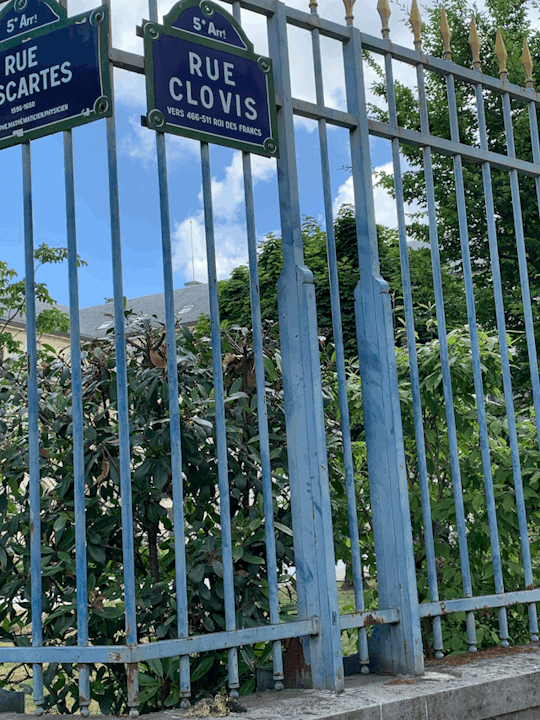
Our third point of interest in the nearby 6ème arrondissement was within walking distance, taking the group by Luxembourg Gardens and various upscale restaurants and shops. Saint Sulpice church was a puzzling sight from the outside, as the construction nearly led us to believe it was closed; however, the Delacroix murals inside challenged us to realize the church’s significance in Paris, despite its relatively unknown origins. The murals Jacob Wrestling with the Angel and Heliodorus Driven from the Temple were directly across from each other on walls. Considering that the murals were painted by an incredibly well known artist, it was surprising that they were relatively tucked away and hidden from the entrance. The murals were incredibly significant in terms of Eugene Delacroix’s artistic legacy, as the National Delacroix Museum noted that the murals were one of his last works.
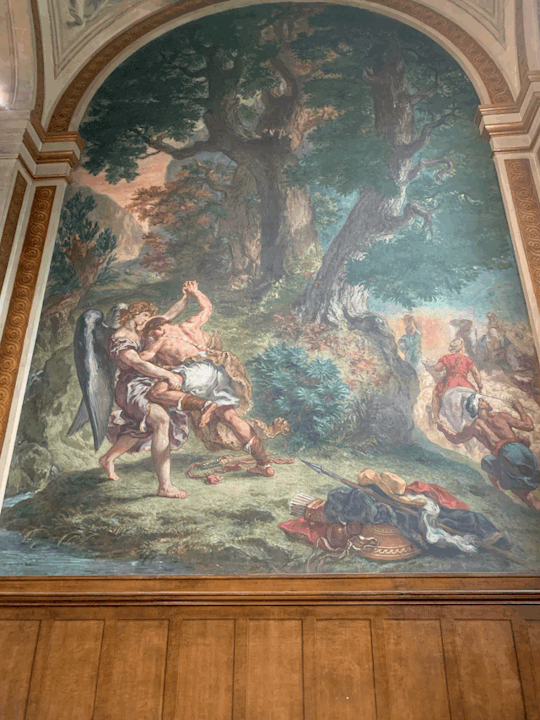

The next point of interest was Église Saint Germain des Près, and it was also walking distance as it is in the 6ème as well. This church seemed to be much more well known than the Saint Sulpice, and it was a familiar name after frequenting the metro in these past few weeks. Seeing the church on the outside raised questions about the age, as we had no clue considering the architectural detail. After reading that it was built in 543 AD (making it the oldest church in Paris), there was a sense of collective shock that the church withstood over a thousand years of wars and development.

Our next location, Pont Alexandre III, is probably one of the most visually dramatic bridges. At each end there are two bright golden statues of Alexander III, the man who laid the foundation stone for the bridge. It serves as a guide to Les Invalides, now an Army Museum and the final resting place for Napoleon. The bridge was built in 1900 and shows off France’s power and wealth.

Once the place of execution by guillotine during the French Revolution, our next stop, the Place de la Concorde, is now a busy roundabout with an obelisk in the center. There are eight statues that surround this obelisk, each representing a different city in France. We visited the Brest statue, which was a woman holding an object that seemed to look like a harp of some sort.
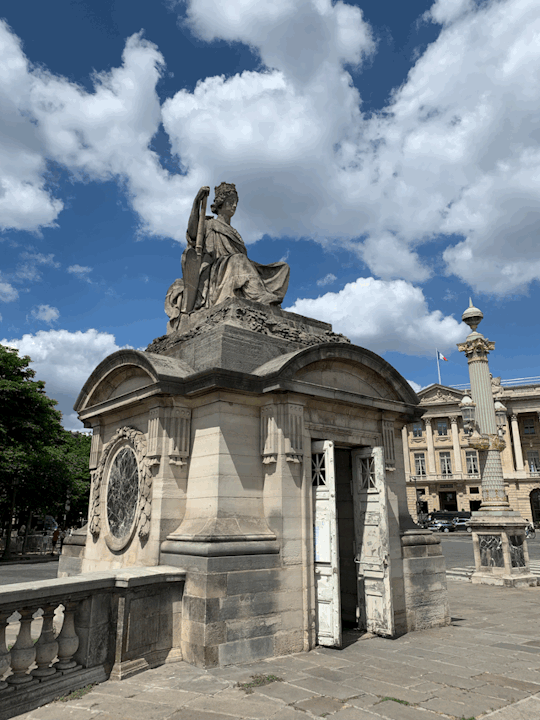
Our next stop was Musee de l’Homme, which translates pretty directly to the museum of mankind, an anthropology museum in the 16th district. The first thing we noticed when we got out of our metro station was the cool view of the Eiffel Tower just to the left of the building. The museum looked relatively small in comparison to some of the massive ones we have visited thus far, but we all agreed that the content looked quite interesting and something to check out either before we leave or the next time we are back.
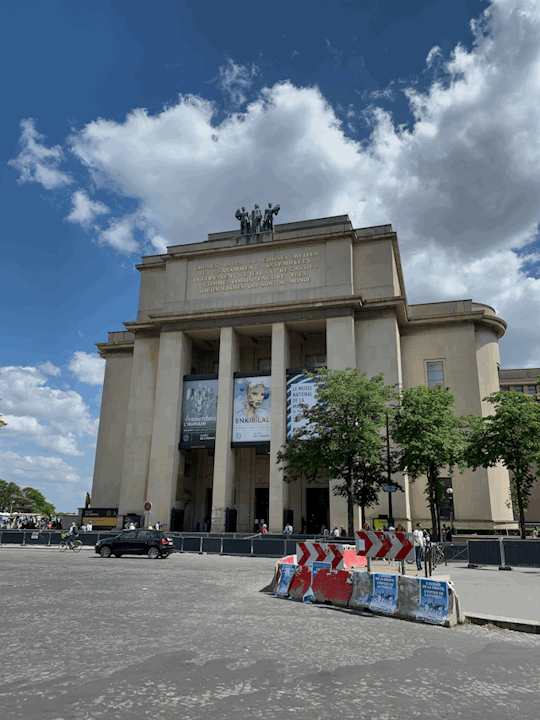
After this, we took a pretty hefty metro ride to get to the Pont tournament de la Grange aux Belles, also known as the turning bridge. We weren’t all too certain of what to expect, especially given that most of the bridges we have walked along thus far have been large and ornate, some containing locks all over the sides. When we arrived, we were pleasantly surprised at how small and unassuming the bridge was. We found it to be a lot more personal than some of the other bridges we have walked on the trip. It also had a pretty cool view of the neighborhood it was surrounded by, which we agreed is an aspect of Paris we have really enjoyed.

It was no easy trek to get to our next stop, the Temple of the Sibyl. The park surrounding this temple is large and beautiful, but also very hilly, and the temple was at the very top; we definitely got a good workout. Unfortunately, due to erosion and safety issues, the temple was closed off, but we were still able to see the lovely view of the trees in the area and the city in the distance. The temple was designed based off of a Roman temple. The Sibyl was a figure in Greek and Roman mythology (usually female) who told prophecies. Although this was a bit of a hike to get to, the views were amazing and it was an excellent spot to finish off our final expedition!
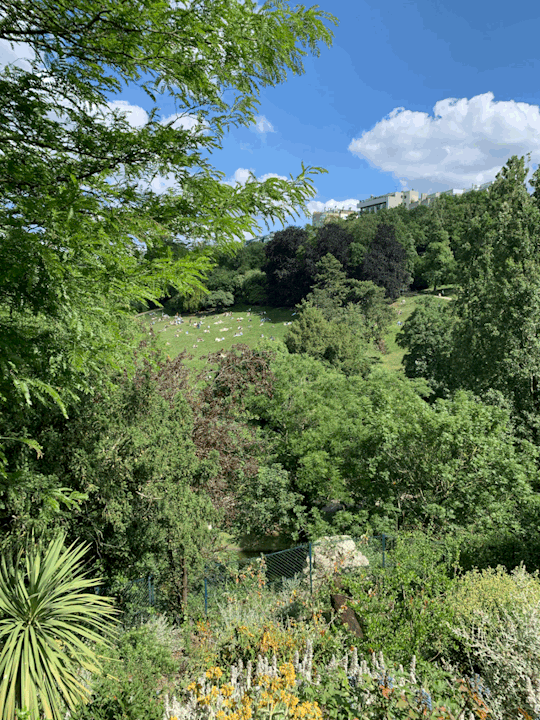
Sources:
https://www.hotel-de-la-marine.paris/en/The-Hotel-de-la-Marine/Place-de-la-Concorde/history-place-concorde
Michelin Green Guide Paris
2 notes
·
View notes
Text
Dans un souci constant d'amélioration de la sécurité routière et de préservation de la qualité de vie de ses habitants, la Commune de Val-de-Travers annonce la prochaine mise en place d'une zone 30 dès l'entrée du village de Saint-Sulpice. Cette initiative s'inscrit dans la continuité des mesures déjà prises par la Commune de Val-de-Travers pour favoriser la mobilité douce et sécuriser les déplacements.
Relire l'article: DES ZONES 30 À MÔTIERS, NOIRAIGUE, TRAVERS ET SAINT-SULPICE
La décision de mettre en place cette zone 30 a été motivée par plusieurs facteurs. Tout d'abord, la configuration géographique de Saint-Sulpice, qui ne constitue pas un axe de transit entre deux localités, rend cette mesure particulièrement pertinente. En limitant la vitesse des véhicules entrant dans le village, on contribue à réduire les risques d'accidents et à garantir un environnement plus sûr pour les résidents et les usagers de la route.
Il est également à noter que cette mesure s'accompagne d'une autre initiative visant à renforcer la sécurité des cyclistes. En effet, la route cantonale reliant le rond-point du Pont de la Roche à l'entrée de Saint-Sulpice sera désormais limitée à 60 km/h. Cette réduction de la vitesse maximale autorisée permettra d'offrir une meilleure protection aux cyclistes, qui pourront ainsi circuler en toute tranquillité et en toute sécurité.
Cette annonce s'inscrit dans une démarche plus large de la Commune de Val-de-Travers visant à promouvoir une mobilité plus durable et respectueuse de l'environnement. En encourageant l'utilisation des modes de transport doux tels que la marche, le vélo ou les transports en commun, la Commune entend contribuer à la réduction de la pollution atmosphérique et à la préservation des espaces naturels qui font la richesse de notre région.
La mise en place de la zone 30 à l'entrée de Saint-Sulpice constitue une avancée significative en matière de sécurité routière et de qualité de vie pour l'ensemble de la population. En adoptant cette mesure, la Commune démontre une fois de plus son engagement en faveur d'une mobilité plus responsable et plus sûre pour tous.
0 notes
Text
The Captain's Vices
François Couppée
I.
It is of no importance, the name of the little provincial city where Captain Mercadier–twenty-six years of service, twenty-two campaigns, and three wounds–installed himself when he was retired on a pension.
It was quite like all those other little villages which solicit without obtaining it a branch of the railway; just as if it were not the sole dissipation of the natives to go every day, at the same hour, to the Place de la Fontaine to see the diligence come in at full gallop, with its gay cracking of the whips and clang of bells.
It was a place of three thousand inhabitants–ambitiously denominated souls in the statistical tables–and was exceedingly proud of its title of chief city of the canton. It had ramparts planted with trees, a pretty river with good fishing, a church of the charming epoch of the flamboyant Gothic, disgraced by a frightful station of the cross, brought directly from the quarter of Saint Sulpice. Every Monday its market was gay with great red and blue umbrellas, and countrymen filled its streets in carts and carriages. But for the rest of the week it retired with delight into that silence and solitude which made it so dear to its rustic population. Its streets were paved with cobble-stones; through the windows of the ground-floor one could see samplers and wax-flowers under glass domes, and, through the gates of the gardens, statuettes of Napoleon in shell-work. The principal inn was naturally called the Shield of France; and the town-clerk made rhymed acrostics for the ladies of society.
Captain Mercadier had chosen that place of retreat for the simple reason that he had been born there, and because, in his noisy childhood, he had pulled down the signs and plugged up the bell-buttons. He returned there to find neither relations, nor friends, nor acquaintances; and the recollections of his youth recalled only the angry faces of shop-keepers who shook their fists at him from the shop-doors, a catechism which threatened him with hell, a school which predicted the scaffold, and, finally, his departure for his regiment, hastened by a paternal malediction.
For the Captain was not a saintly man; the old record of his punishment was black with days in the guard-house inflicted for breaches of discipline, absences from roll-calls, and nocturnal uproars in the mess-room. He had often narrowly escaped losing his stripes as a corporal or a sergeant, and he needed all the chance, all the license of a campaigning life to gain his first epaulet. Firm and brave soldier, he had passed almost all his life in Algiers at that time when our foot soldiers wore the high shako, white shoulder-belts and huge cartridge-boxes. He had had Lamoriciere for commander. The Due de Nemours, near whom he received his first wound, had decorated him, and when he was sergeant-major, Pere Bugrand had called him by his name and pulled his ears. He had been a prisoner of Abd-el-Kader, bearing the scar of a yataghan stroke on his neck, of one ball in his shoulder and another in his chest; and notwithstanding absinthe, duels, debts of play, and almond-eyed Jewesses, he fairly won, with the point of the bayonet and sabre, his grade of captain in the First Regiment of Sharp-shooters.
Captain Mercadier–twenty-six years of service, twenty-two campaigns, and three wounds–had just retired on his pension, not quite two thousand francs, which, joined to the two hundred and fifty francs from his cross, placed him in that estate of honorable penury which the State reserves for its old servants.
His entry into his natal city was without ostentation. He arrived one morning on the imperiale of the diligence, chewing an extinguished cigar, and already on good terms with the conductor, to whom, during his journey, he had related the passage of the Porte de Fer; full of indulgence, moreover, for the distractions of his auditor, who often interrupted the recital by some oath or epithet addressed to the off mare. When the diligence stopped he threw on the sidewalk his old valise, covered with railway placards as numerous as the changes of garrison that its proprietor had made, and the idlers of the neighborhood were astonished to see a man with a decoration–a rare thing in the province–offer a glass of wine to the coachman at the bar of an inn near by.
He installed himself at once. In a house in the outskirts, where two captive cows lowed, and fowls and ducks passed and repassed through the gate-way, a furnished chamber was to let. Preceded by a masculine-looking woman, the Captain climbed the stair-way with its great wooden balusters, perfumed by a strong odor of the stable, and reached a great tiled room, whose walls were covered with a bizarre paper representing, printed in blue on a white background and repeated infinitely, the picture of Joseph Poniatowski crossing the Elster on his horse. This monotonous decoration, recalling nevertheless our military glories, fascinated the Captain without doubt, for, without concerning himself with the uncomfortable straw chairs, the walnut furniture, or the little bed with its yellowed curtain, he took the room without hesitation. A quarter of an hour was enough to empty his trunk, hang up his clothes, put his boots in a corner, and ornament the wall with a trophy composed of three pipes, a sabre, and a pair of pistols. After a visit to the grocer’s, over the way, where he bought a pound of candles and a bottle of rum, he returned, put his purchase on the mantle-shelf, and looked around him with an air of perfect satisfaction. And then, with the promptitude of the camp, he shaved without a mirror, brushed his coat, cocked his hat over his ear, and went for a walk in the village in search of a cafe.
II.
It was an inveterate habit of the Captain to spend much of his time at a cafe. It was there that he satisfied at the same time the three vices which reigned supreme in his heart–tobacco, absinthe, and cards. It was thus that he passed his life, and he could have drawn a plan of all the places where he had ever been stationed by their tobacco shops, cafes, and military clubs. He never felt himself so thoroughly at ease as when sitting on a worn velvet bench before a square of green cloth near a heap of beer-mugs and saucers. His cigar never seemed good unless he struck his match under the marble of the table, and he never failed, after hanging his hat and his sabre on a hat-hook and settling himself comfortably, by unloosing one or two buttons of his coat, to breathe a profound sigh of relief, and exclaim,
“That is better!”
His first care was, therefore, to find an establishment which he could frequent, and after having gone around the village without finding anything that suited him, he stopped at last to regard with the eye of a connoisseur the Cafe Prosper, situated at the corner of the Place du Marche and the Rue de la Pavoisse.
It was not his ideal. Some of the details of the exterior were too provincial: the waiter, in his black apron, for example, the little stands in their green frames, the footstools, and the wooden tables covered with waxed cloth. But the interior pleased the Captain. He was delighted upon his entrance by the sound of the bell which was touched by the fair and fleshy dame du comptoir, in her light dress, with a poppy-colored ribbon in her sleek hair. He saluted her gallantly, and believed that she sustained with sufficient majesty her triumphal place between two piles of punch-bowls properly crowned by billiard-balls. He ascertained that the place was cheerful, neat, and strewn evenly with yellow sand. He walked around it, looking at himself in the glasses as he passed; approved the panels where guardsmen and amazons were drinking champagne in a landscape filled with red holly-hocks; called for his absinthe, smoked, found the divan soft and the absinthe good, and was indulgent enough not to complain of the flies who bathed themselves in his glass with true rustic familiarity.
Eight days later he had become one of the pillars of the Cafe Prosper.
They soon learned his punctual habits and anticipated his wishes, while he, in turn, lunched with the patrons of the place–a valuable recruit for those who haunted the cafe, folks oppressed by the tedium of a country life, for whom the arrival of that new-comer, past master in all games, and an admirable raconteur of his wars and his loves, was a true stroke of good-fortune. The Captain himself was delighted to tell his stories to folks who were still ignorant of his repertoire. There were fully six months before him in which to tell of his games, his feats, his battles, the retreat of Constantine, the capture of Bou-Maza, and the officers’ receptions with the concomitant intoxication of rum-punch.
Human weakness! He was by no means sorry, on his part, to be something of an oracle; he from whom the sub-lieutenants, new-comers at Saint-Cyr, fled dismayed, fearing his long stories.
His usual auditors were the keeper of the cafe, a stupid and silent beer-cask, always in his sleeved vest, and remarkable only for his carved pipe; the bailiff, a scoffer, dressed invariably in black, scorned for his inelegant habit of carrying off what remained of his sugar; the town-clerk, the gentleman of acrostics, a person of much amiability and a feeble constitution, who sent to the illustrated journals solutions of enigmas and rebuses; and, lastly, the veterinary surgeon of the place, the only one who, from his position of atheist and democrat, was allowed to contradict the Captain. This practitioner, a man with tufted whiskers and eye-glasses, presided over the radical committee of electors, and when the cure took up a little collection among his devotees for the purpose of adorning his church with some frightful red and gilded statues, denounced, in a letter to the Siecle, the cupidity of the Jesuits.
The Captain having gone out one evening for some cigars after an animated political discussion, the aforesaid veterinary grumbled to himself certain phrases of heavy irritation concerning “coming to the point,” and “a mere fencing-master,” and “cutting a figure.” But as the object of these vague menaces suddenly returned, whistling a march and beating time with his cane, the incident was without result.
In short, the group lived harmoniously together, and willingly permitted themselves to be presided over by the new-comer, whose white beard and martial bearing were quite impressive. And the small city, proud of so many things, was also proud of its retired Captain.
III.
Perfect happiness exists nowhere, and Captain Mercadier, who believed that he had found it at the Cafe Prosper, soon recovered from his illusion.
For one thing, on Mondays, the market-day, the Cafe Prosper was untenantable.
From early morning it was overrun with truck-peddlers, farmers, and poultrymen. Heavy men with coarse voices, red necks, and great whips in their hands, wearing blue blouses and otter-skin caps, bargaining over their cups, stamping their feet, striking their fists, familiar with the servant, and bungling at billiards.
When the Captain came, at eleven o’clock, for his first glass of absinthe, he found this crowd gathered, and already half-drunk, ordering a quantity of lunches. His usual place was taken, and he was served slowly and badly. The bell was continually sounding, and the proprietor and the waiter, with napkins under their arms, were running distractedly hither and thither. In short, it was an ill-omened day, which upset his entire existence.
Now, one Monday morning, when he was resting quietly at home, being sure that the cafe would be much too full and busy, the mild radiance of the autumn sun persuaded him to go down and sit upon the stone seat by the side of the house. He was sitting there, depressed and smoking a damp cigar, when he saw coming down the end of the street–it was a badly paved lane leading out into the country–a little girl of eight or ten, driving before her a half-dozen geese.
As the Captain looked carelessly at the child he saw that she had a wooden leg.
There was nothing paternal in the heart of the soldier. It was that of a hardened bachelor. In former days, in the streets of Algiers, when the little begging Arabs pursued him with their importunate prayers, the Captain had often chased them away with blows from his whip; and on those rare occasions when he had penetrated the nomadic household of some comrade who was married and the father of a family, he had gone away cursing the crying babies and awkward children who had touched with their greasy hands the gilding on his uniform.
But the sight of that particular infirmity, which recalled to him the sad spectacle of wounds and amputations, touched, on that account, the old soldier. He felt almost a constriction of the heart at the sight of that sorry creature, half-clothed in her tattered petticoats and old chemise, bravely running along behind her geese, her bare foot in the dust, and limping on her ill-made wooden stump.
The geese, recognizing their home, turned into the poultry-yard, and the little one was about to follow them when the Captain stopped her with this question:
“Eh! little girl, what’s your name?”
“Pierette, monsieur, at your service,” she answered, looking at him with her great black eyes, and pushing her disordered locks from her forehead.
“You live in this house, then? I haven’t seen you before.”
“Yes, I know you pretty well, though, for I sleep under the stairs, and you wake me up every evening when you come home.”
“Is that so, my girl? Ah, well, I must walk on my toes in future. How old are you?”
“Nine, monsieur, come All-Saints day.”
“Is the landlady here a relative of yours?”
“No, monsieur, I am in service.”
“And they give you?”
“Soup, and a bed under the stairs.”
“And how came you to be lame like that, my poor little one?”
“By the kick of a cow when I was five.”
“Have you a father or mother?”
The child blushed under her sunburned skin. “I came from the Foundling Hospital,” she said, briefly. Then, with an awkward courtesy, she passed limping into the house, and the Captain heard, as she went away on the pavement of the court, the hard sound of the little wooden leg.
Good heavens! he thought, mechanically walking towards his cafe, that’s not at all the thing. A soldier, at least, they pack off to the Invalides, with the money from his medal to keep him in tobacco. For an officer, they fix up a collectorship, and he marries somewhere in the provinces. But this poor girl, with such an infirmity,–that’s not at all the thing!
Having established in these terms the injustice of fate, the Captain reached the threshold of his dear cafe, but he saw there such a mob of blue blouses, he heard such a din of laughter and click of billiard-balls, that he returned home in very bad humor.
His room–it was, perhaps, the first time that he had spent in it several hours of the day–looked rather shabby. His bed-curtains were the color of an old pipe. The fireplace was heaped with old cigar-stumps, and one could have written his name in the dust on the furniture. He contemplated for some time the walls where the sublime lancer of Leipsic rode a hundred times to a glorious death. Then, for an occupation, he passed his wardrobe in review. It was a lamentable series of bottomless pockets, socks full of holes, and shirts without buttons.
“I must have a servant,” he said.
Then he thought of the little lame girl.
“That’s what I’ll do. I’ll hire the next little room; winter is coming, and the little thing will freeze under the stairs. She will look after my clothes and my linen and keep the barracks clean. A valet, how’s that?”
But a cloud darkened the comfortable picture. The Captain remembered that quarter-day was still a long way off, and that his account at the Cafe Prosper was assuming alarming proportions.
“Not rich enough,” he said to himself. “And in the mean time they are robbing me down there. That is positive. The board is too high, and that wretch of a veterinary plays bezique much too well. I have paid his way now for eight days. Who knows? Perhaps I had better put the little one in charge of the mess, soup au cafe in the morning, stew at noon, and ragout every evening–campaign life, in fact. I know all about that. Quite the thing to try.”
Going out he saw at once the mistress of the house, a great brutal peasant, and the little lame girl, who both, with pitchforks in their hands, were turning over the dung-heap in the yard.
“Does she know how to sew, to wash, to make soup?” he asked, brusquely.
“Who–Pierette? Why?”
“Does she know a little of all that?”
“Of course. She came from an asylum where they learn how to take care of themselves.”
“Tell me, little one,” added the Captain, speaking to the child, “I am not scaring you–no? Well, my good woman, will you let me have her? I want a servant.”
“If you will support her.”
“Then that is finished. Here are twenty francs. Let her have to-night a dress and a shoe. To-morrow we’ll arrange the rest.”
And, with a friendly tap on Pierette’s cheek, the Captain went off, delighted that everything was concluded. Possibly he thought he would have to cut off some glasses of beer and absinthe, and be cautious of the veterinary’s skill at bezique. But that was not worth speaking of, and the new arrangement would be quite the thing.
IV.
Captain, you are a coward!
Such was the apostrophe with which the caryatides of the Cafe Prosper hereafter greeted the Captain, whose visits became rarer day by day.
For the poor man had not seen all the consequences of his good action. The suppression of his morning absinthe had been sufficient to cover the modest expense of Pierette’s keeping, but how many other reforms were needed to provide for the unforeseen expenses of his bachelor establishment! Full of gratitude, the little girl wished to prove it by her zeal. Already the aspect of his room was changed. The furniture was dusted and arranged, the fireplace cleaned, the floor polished, and spiders no longer spun their webs over the deaths of Poniatowski in the corner. When the Captain came home the inviting odor of cabbage-soup saluted him on the staircase, and the sight of the smoking plates on the coarse but white table-cloth, with a bunch of flowers and polished table-ware, was quite enough to give him a good appetite. Pierette profited by the good-humor of her master to confess some of her secret ambitions. She wanted andirons for the fireplace, where there was now always a fire burning, and a mould for the little cakes that she knew how to make so well. And the Captain, smiling at the child’s requests, but charmed with the homelike atmosphere of his room, promised to think of it, and on the morrow replaced his Londres by cigars for a sou each, hesitated to offer five points at ecarte, and refused his third glass of beer or his second glass of chartreuse.
Certainly the struggle was long; it was cruel. Often, when the hour came for the glass that was denied him by economy, when thirst seized him by the throat, the Captain was forced to make an heroic effort to withdraw his hand already reaching out towards the swan’s beak of the cafe; many times he wandered about, dreaming of the king turned up and of quint and quatorze. But he almost always courageously returned home; and as he loved Pierette more through every sacrifice that he made for her, he embraced her more fondly every day. For he did embrace her. She was no longer his servant. When once she stood before him at the table, calling him “Monsieur,” and so respectful in her bearing, he could not stand it, but seizing her by her two hands, he said to her, eagerly:
“First embrace me, and then sit down and do me the pleasure of speaking familiarly, confound it!”
And so to-day it is accomplished. Meeting a child has saved that man from an ignominious age.
He has substituted for his old vices a young passion. He adores the little lame girl who skips around him in his room, which is comfortable and well furnished.
He has already taught Pierette to read, and, moreover, recalling his calligraphy as a sergeant-major, he has set her copies in writing. It is his greatest joy when the child, bending attentively over her paper, and sometimes making a blot which she quickly licks up with her tongue, has succeeded in copying all the letters of an interminable adverb in ment. His uneasiness is in thinking that he is growing old and has nothing to leave his adopted child.
And so he becomes almost a miser; he theorizes; he wishes to give up his tobacco, although Pierette herself fills and lights his pipe for him. He counts on saving from his slender income enough to purchase a little stock of fancy goods. Then when he is dead she can live an obscure and tranquil life, hanging up somewhere in the back room of the small shop an old cross of the Legion of Honor, her souvenir of the Captain.
Every day he goes to walk with her on the rampart. Sometimes they are passed by folks who are strangers in the village, who look with compassionate surprise at the old soldier, spared from the wars, and the poor lame child. And he is moved–oh, so pleasantly, almost to tears–when one of the passers-by whispers, as they pass:
“Poor father! Yet how pretty his daughter is.”
1 note
·
View note
Text
Taxi Rennes vers Fougères
Tarif Taxi Rennes FougèresJTNDdGFibGUlM0UlMEElMjAlMjAlMEElMjAlMjAlM0Njb2xncm91cCUzRSUwQSUwQSUzQ2NvbCUyMHN0eWxlJTNEJTIyd2lkdGglM0EyMDBweCUyMiUzRSUwQSUwQSUzQ2NvbCUzRSUwQSUwQSUzQ2NvbCUzRSUwQSUwQSUzQyUyRmNvbGdyb3VwJTNFJTBBJTBBJTNDdHIlM0UlMjAlM0N0aCUzRVRheGklMjBhJUMzJUE5cm9wb3J0JTIwUmVubmVzJTIwJTNDJTJGdGglM0UlMjAlM0N0aCUzRSUyMHZlcnMlMjBGb3VnJUMzJUE4cmVzJTNDJTJGdGglM0UlMjAlM0MlMkZ0ciUzRSUwQSUwQSUzQ3RyJTNFJTIwJTNDdGQlM0VEaXN0YW5jZSUyMFRyYWpldCUzQyUyRnRkJTNFJTIwJTNDdGQlM0U1OSUyMEttJTNDJTJGdGQlM0UlMjAlM0MlMkZ0ciUzRSUwQSUwQSUzQ3RyJTNFJTIwJTNDdGQlM0VEdXIlQzMlQTllJTIwJTNDJTJGdGQlM0UlMjAlM0N0ZCUzRSUyMDQ1JTIwbWluJTNDJTJGdGQlM0UlMjAlM0MlMkZ0ciUzRSUwQSUwQSUzQ3RyJTNFJTIwJTNDdGQlM0UlMjBUYXJpZiUyMEpvdXIlM0MlMkZ0ZCUzRSUyMCUzQ3RkJTNFJTIwMTAwJTIwJUUyJTgyJUFDJTNDJTJGdGQlM0UlMjAlM0MlMkZ0ciUzRSUwQSUwQSUzQ3RyJTNFJTIwJTNDdGQlM0UlMjBUYXJpZiUyME51aXQlM0MlMkZ0ZCUzRSUyMCUzQ3RkJTNFJTIwMTQ1JTIwJUUyJTgyJUFDJTNDJTJGdGQlM0UlMjAlM0MlMkZ0ciUzRSUwQSUwQSUzQyUyRnRhYmxlJTNF
Découvrez Fougères en toute facilité avec Rennes-taxi35, votre entreprise de taxi de confiance !
À la recherche d'un moyen pratique et fiable pour vous rendre à Fougères et explorer ses célèbres endroits touristiques ? Ne cherchez plus ! Rennes-taxi35 est là pour répondre à tous vos besoins de transport dans cette magnifique ville côtière.
Que vous soyez un touriste désireux de découvrir les merveilles de Fougères ou un voyageur d'affaires pressé, notre équipe de chauffeurs expérimentés et courtois est là pour vous offrir un service de transport exceptionnel. Nous mettons un point d'honneur à vous fournir un trajet sûr, confortable et ponctuel, afin que vous puissiez profiter pleinement de votre séjour à Fougères.
Lorsque vous choisissez Rennes-taxi35, vous bénéficiez non seulement d'un service de qualité, mais également des connaissances locales de nos chauffeurs. Ils sont bien informés sur les meilleurs itinéraires pour vous conduire vers les attractions touristiques incontournables de Fougères. Parmi ces endroits célèbres, ne manquez pas :
Le magnifique château de Fougères
Le magnifique château de Fougères, un trésor historique qui témoigne du riche passé de la région. Avec ses tours imposantes et ses remparts bien conservés, le château offre une vue imprenable sur la ville et ses environs.
Le jardin public de Fougères
Le jardin public de Fougères, un havre de tranquillité au cœur de la ville. Ce parc bien aménagé est idéal pour une promenade relaxante ou un pique-nique en famille. Les amoureux de la nature apprécieront la variété de plantes et de fleurs.
L'église Saint-Sulpice
L'église Saint-Sulpice, un chef-d'œuvre d'architecture religieuse. Son intérieur orné de détails élaborés et de vitraux colorés en fait un lieu de visite incontournable pour les amateurs d'art et d'histoire.
Le musée Emmanuel-de-la-Villéon
Le musée Emmanuel-de-la-Villéon, où vous pourrez explorer une collection captivante d'œuvres d'art et d'objets historiques liés à la région. C'est une excellente occasion d'en apprendre davantage sur l'histoire locale.
La vieille ville pittoresque
La vieille ville pittoresque, avec ses ruelles pavées et ses maisons à colombages. Se promener dans ce quartier vous fera voyager dans le temps, tandis que vous découvrirez des boutiques artisanales et des cafés charmants.
En choisissant les services des chauffeurs VTC de la région, vous pourrez découvrir tous ces sites exceptionnels sans vous soucier des détails logistiques. Leur connaissance du terrain et leur engagement envers votre confort rendront votre visite à Fougères des plus agréables.
N'hésitez pas à visiter ces attractions lors de votre séjour à Fougères. Vous ne le regretterez pas !
Que vous souhaitiez visiter ces lieux emblématiques ou explorer d'autres trésors cachés de Fougères, Rennes-taxi35 est là pour vous emmener en toute sécurité et confort. Nous sommes flexibles et disponibles 24 heures sur 24, 7 jours sur 7, afin de répondre à tous vos besoins de transport.
Réserver un taxi en ligne à Fougères
Vous souhaitez prendre un taxi depuis Fougères ou vous y rendre ?
Vous êtes un touriste en visite dans la région, un résident local ou un homme d'affaires en visite chez un client ou un fournisseur ?
Nos chauffeurs taxis sont disponibles 24h/24 et 7j/7, jour et nuit, pour vous emmener partout en France et en Europe.
Vous souhaitez savoir combien vous coûtera votre taxi ?
Utilisez notre calculateur de prix taxi pour obtenir le tarif forfaitaire qui convient le mieux à votre trajet.
Aller en taxi de Fougères à l’aéroport de Rennes
Si vous cherchez un taxi de l'aéroport de Rennes Saint Jaques vers ou depuis Fougères, ne cherchez pas plus loin ! Nous sommes les meilleurs de la ville et nous savons ce que signifie être local.
L'aéroport de Rennes Saint Jaques est un point de départ idéal pour se rendre à Fougères, en France. Si vous voyagez de Rennes à Fougères, réserver votre voyage dès maintenant avec Taxi Rennes35 ou bien appelez-nous sur 02 30 02 51 39
Fougères est une destination populaire pour les voyageurs en raison de ses belles plages, de ses sites historiques et de ses merveilles naturelles. Elle possède également de nombreuses attractions telles que les plages exceptionnelles de Fougères, dont on cite la Plage de Port Mer, la Plage du Saussaye et la Plage du Verger, qui offrent du sable fin, des eaux claires et des paysages pittoresques. Si vous cherchez un moyen de vous rendre de l'aéroport de Rennes Saint Jacques à Fougères, obtenez un taxi de l'aéroport de Rennes Saint Jaques vers ou depuis Fougères en moins d'une heure avec notre module de réservation en ligne facile !
- Aéroport de Nantes Atlantique
- Aéroport de Rennes - Saint-Jacques
- Aéroport de Saint-Nazaire - Montoir
- Aéroport de Saint-Brieuc - Armor
Taxi Rennes / Rennes-taxi35 est un service de taxi qui fournit un moyen fiable, abordable et sûr de se déplacer de Rennes vers Fougères.
Réservez votre taxi dès maintenant !
Le taxi Rennes - Fougères est un trajet de 1 heure. Le taxi vous emmènera dans un voyage confortable qui se terminera dans la ville de Fougères.
Nous nous engageons à fournir à nos clients un service exceptionnel à tout moment.
Nous sommes fiers d'être fiables et ponctuels pour vos transferts aéroport et gare.
Nous nous sommes forgés une excellente réputation auprès de nos clients au fil du temps.
Nos chauffeurs sont tous des professionnels expérimentés. Ils sont en mesure de fournir leurs services dans n'importe quelle partie de la France ou à l'étranger.
Nous vous assurons que votre trajet est aussi sûr et confortable que possible.
Hélez un taxi ou attendez à la station de taxis à Fougères
N'attendez plus ! Laissez Rennes-taxi35 vous accompagner lors de votre prochaine visite à Fougères et profitez d'un transport sans soucis vers ces endroits touristiques inoubliables. Contactez-nous dès maintenant pour réserver votre trajet ou obtenir plus d'informations sur nos services.
Vous devez réserver à l'avance pour garantir l'accès à un taxi pour votre trajet vers et depuis Fougères. Renseignez-vous sur les tarifs en remplissant le formulaire. Réserver avec nous, c'est la garantie d'avoir un chauffeur noté à un prix fixe et compétitif.
JTNDdGFibGUlM0UlMEElMjAlMjAlMEElMjAlMjAlMEElMjAlMjAlM0Njb2xncm91cCUzRSUwQSUwQSUzQ2NvbCUyMHN0eWxlJTNEJTIyd2lkdGglM0EyMDBweCUyMiUzRSUwQSUwQSUzQ2NvbCUzRSUwQSUwQSUzQ2NvbCUzRSUwQSUwQSUzQyUyRmNvbGdyb3VwJTNFJTBBJTBBJTNDdHIlM0UlMjAlM0N0aCUzRSUyMCUzQyUyRnRoJTNFJTIwJTNDdGglM0VUYXJpZiUyMEVzdGltJUMzJUE5JTIwSm91ciUzQyUyRnRoJTNFJTIwJTNDdGglM0VUYXJpZiUyMEVzdGltJUMzJUE5JTIwTnVpdCUzQyUyRnRoJTNFJTIwJTNDJTJGdHIlM0UlMEElMEElM0N0ciUzRSUyMCUzQ3RkJTNFVEFYSSUyMFJFTk5FUyUyMC0lMjBBRVJPUE9SVCUyMFNBSU5ULUpBQ1FVRVMlM0MlMkZ0ZCUzRSUyMCUzQ3RkJTNFMTglRTIlODIlQUMlMjAtJTIwMjUlRTIlODIlQUMlM0MlMkZ0ZCUzRSUyMCUzQ3RkJTNFMjQlRTIlODIlQUMlMjAtJTIwNDAlRTIlODIlQUMlM0MlMkZ0ZCUzRSUyMCUzQyUyRnRyJTNFJTBBJTBBJTNDdHIlM0UlMjAlM0N0ZCUzRVRBWEklMjBSRU5ORVMlMjAtJTIwR0FSRSUyMERFJTIwUkVOTkVTJTIwJTNDJTJGdGQlM0UlMjAlM0N0ZCUzRTE1JUUyJTgyJUFDJTIwLSUyMDIwJUUyJTgyJUFDJTNDJTJGdGQlM0UlMjAlM0N0ZCUzRTIyJUUyJTgyJUFDJTIwLSUyMDI2JUUyJTgyJUFDJTNDJTJGdGQlM0UlMjAlM0MlMkZ0ciUzRSUwQSUwQSUzQ3RyJTNFJTIwJTNDdGQlM0VUQVhJJTIwUkVOTkVTJTIwLSUyMERJTkFSRCUzQyUyRnRkJTNFJTIwJTNDdGQlM0UxNDAlRTIlODIlQUMlMjAtJTIwMTQ1JUUyJTgyJUFDJTNDJTJGdGQlM0UlMjAlM0N0ZCUzRTE5NSVFMiU4MiVBQyUyMC0lMjAyMDAlRTIlODIlQUMlM0MlMkZ0ZCUzRSUyMCUzQyUyRnRyJTNFJTBBJTBBJTNDdHIlM0UlMjAlM0N0ZCUzRVRBWEklMjBSRU5ORVMlMjAtJTIwU0FJTlQlMjBNQUxPJTNDJTJGdGQlM0UlMjAlM0N0ZCUzRTEzMCVFMiU4MiVBQyUyMC0lMjAxMzUlRTIlODIlQUMlM0MlMkZ0ZCUzRSUyMCUzQ3RkJTNFMTgwJUUyJTgyJUFDJTIwLSUyMDE4NSVFMiU4MiVBQyUzQyUyRnRkJTNFJTIwJTNDJTJGdHIlM0UlMEElMEElM0N0ciUzRSUyMCUzQ3RkJTNFVEFYSSUyMFJFTk5FUyUyMC0lMjBGT1VHRVJFUyUzQyUyRnRkJTNFJTIwJTNDdGQlM0UxMDAlRTIlODIlQUMlMjAtJTIwMTA1JUUyJTgyJUFDJTNDJTJGdGQlM0UlMjAlM0N0ZCUzRTE0NSVFMiU4MiVBQyUyMC0lMjAxNTAlRTIlODIlQUMlM0MlMkZ0ZCUzRSUyMCUzQyUyRnRyJTNFJTBBJTBBJTNDJTJGdGFibGUlM0U=
La distance entre Rennes et Fougères étant d'environ 59 km, le tarif de la course de taxi est d'environ 145€ pour les trajets de nuit et de 100€ pour ceux effectués en jour.
Nous facilitons également la réservation de votre voyage via notre module de réservation. Entrez simplement votre destination et sélectionnez les dates de voyage. Vous obtiendrez une estimation de vos frais de déplacement gratuitement.
Vous pouvez avoir un voyage sûr, facile et confortable avec nous. Nos chauffeurs ont des formations professionnels pour s'assurer que vous atteignez votre destination en toute sécurité. Nous avons également fait en sorte qu'il soit facile pour vous de réserver votre voyage via notre site web en 3 clics. Il vous suffit d'entrer votre destination et de sélectionner la date du voyage. Vous obtiendrez une estimation du coût du trajet.
Le taxi Rennes - Fougères est un trajet que vous pouvez réserver en quelques clics. La réservation de ce trajet est facile et le prix est toujours compétitif. Vous pouvez également utiliser notre module de réservation en ligne facile, rapide et gratuit pour voir le prix actuel de votre course avant de réserver.
La réservation de taxi à Fougères offre plusieurs avantages pour les utilisateurs.
Tout d'abord, elle est très pratique car elle permet d'organiser son trajet à l'avance, sans avoir à chercher un taxi au dernier moment. Vous pouvez connaître le tarif via notre module de réservation en ligne. Enfin, la réservation de taxi permet de voyager en toute sécurité car les chauffeurs sont des professionnels qui respectent les règles de conduite et les normes de sécurité.
Oui, il est tout à fait possible de réserver un taxi tard dans la nuit ou tôt le matin. Nos services de taxi sont disponibles 24 heures sur 24, 7 jours sur 7 pour répondre aux besoins des clients qui ont besoin d'un taxi à des heures inhabituelles. Vous pouvez réserver un taxi en utilisant notre module de réservation gratuit sur le site web ou en appelant directement notre service de taxi +33230025139.
Un taxi réglementé coûte 100 € . Pour les groupes plus importants, veuillez envoyer une demande de devis.
Distance : 59 km Durée : 45 minutes.
Vous pouvez réserver un taxi en utilisant notre module de réservation gratuit sur le site web ou en appelant directement notre service de taxi +33 2 30 02 51 39.
Vous pouvez réserver un taxi en utilisant notre module de réservation gratuit sur le site web ou en appelant directement notre service de taxi +33230025139.
Normalement, un taxi coûte 125 € tarif jour.
Distance: 59 km Durée: 46 minutes
Vous pouvez réserver un taxi en utilisant notre module de réservation gratuit sur le site web ou en appelant directement notre service de taxi +33230025139.
Normalement, un taxi coûte 125 € tarif de jour et 184 € tarif de nuit.
Distance: 59 km Durée: 46 min
Vous pouvez réserver un taxi en utilisant notre module de réservation gratuit sur le site web ou en appelant directement notre service de taxi +33230025139.
Read the full article
0 notes
Text
[Point de vue] Tout n’est peut-être pas fichu…
Durant le week-end de la Pentecôte, les observateurs ont été surpris du magnifique succès obtenu par le pèlerinage de Chartres qu’organisait l’association Notre-Dame de Chrétienté. En effet ,16.000 personnes, essentiellement des jeunes, avaient effectué, sans sourciller, sans se cacher, assumant leur foi, le parcours de 100 km entre l’église de Saint-Sulpice (Paris) et la cathédrale de…
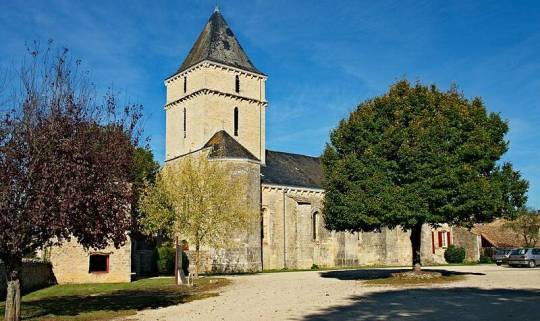
View On WordPress
0 notes
Link
0 notes
Text
SUMMONED AND DEFILED

Il faisait encore jour quand je partais de Castres, ville rugueuse d’ovalie, porteuse d’une victoire contre le RC Toulonnais en ce jour du 22 avril 2023. Dans les rues des supporters rentraient à pied, drapeau sur l’épaule, se chambrant gaiement. Des cumulus nimbus offraient un parterre de teinte grisâtre et laiteuse avec des trouées minimale de lumière, comme si des jets venaient à percer dans une obscurité naissante. Bientôt la pluie le long du trajet tomberait, et fera abattre le ciel sur terre dans une nappe de brouillard épaisse, et de crachin que cette nuit en enfer allait offrir à coups de décibel tellurique, de cris perçant et d’hémoglobine sonique. La nappe phréatique de mes émotions remonterait jusqu’à ma paroi nasale en laissant couler un filet de sang, pour une raison que j’ignore encore, mais qui demeure un présage de la déflagration reçue.
L’association Profusion existe depuis 1995, elle a mis en place des concerts dans le Tarn et la région toulousaine. Depuis St Sulpice, la première édition d'Une Nuit En Enfer a été effectué en 2003 où elle avait posé les bases d’une intention fidèle à l’underground oldschool. Pour ses 20 ans c’est « Be there or be dead », PAF 15 Euros. Pas de CB, rien que de la fraîche, à l’ancienne (vise le flyer). Lieu = Salle René Cassin / 81370 Saint Sulpice La pointe.
Les groupes ayant joué dans une nuit en enfer sont Fall Of Seraphs, Iron Flesh, Ritualization, Mercyless, Asmodée, Agressor, Necrowretch, Charnier, Fatal Nunchaku, Graveyard, Hate Wanted, Hypnosis, Hypoptalasias, Inhumate, Les Incapables, Malhkebre, Necrocult, Oldskull, Offending, Ossuaire, Otargos, Ouroboros, Pestiferum, Pulmonary Fibrosis, Putrefaction, Ruins Division, The Bottle Doom Lazy Band, The Seven Gates, Temple Of Baal, Trashnasty, Vorkreist, Withdrawn.

C’est OLDSKULL qui éventre la nuit comme l’on ouvre une parenthèse pour marquer les esprits. Son death metal touille Obituary (mais sans le groove) et Morbid Angel avec une lichette de Bolt Thrower, et parfois des grumeaux thrashy dans les riffs et rythmiques.
Le chanteur avait un t-shirt de Power Trip, et son growl de bons caillots de sang dans la glotte pour projeter son impureté deathalique. Le batteur du groupe avait le son de la caisse claire d'une bouteille que l'on décapsule, car pas de peau sablé. Je dis ceci car un gonze me l’a fait remarquer alors que jusque-là je n’y avais pas prêté cas. L'ingé son a assuré, je ne veux pas dire de connerie, mais il me semble qu’il travaillait à l’ancienne salle du Bikini, au 54 chemin des Étroits à Tolosa, car la façade démontrait un son de gouffre à death metOl. Scéniquement la scène n’est pas immense, les gars font leur set dans un condensé salé de leur sauce dégoulinante, ça envoie une bonne rasade oldschool, avec pour les light, un spot bleu, un rouge, un jaune, un peu de fumée et va chier à la vigne.
Dans une nuit en enfer il n'y a pas de poseurs, pas de kikouyou à licorne, de touristes, de personnes qui vivent dans un trou de hobbit, nannn. L'atmosphère est oldschool, il y a en présence une majorité de gars qui turbinent avec sincérité depuis l'époque des échanges de K7. L’underground c’est une niche, un endroit en marge, reclus, parfois trop, enfin tout dépend comment tu vois le truc. C’est un isolement, et pas du tout à la fois. Beaucoup y trouvent leur compte, du moins un temps, après les époques meurent et les nouvelles prennent leur place, il y a des personnes qui restent fidèles malgré tout. Oui ça existe.

L’underground fonctionne sur le principe du participatif, et généralement en autarcie. Ces passionné.es peuvent passer du statut d’inconnu à culte, mais c’est très rare, et pas du tout l’effet escompté. Le premier c’est d’être libre de créer, de faire émerger un art, une discipline, l’esprit d’une musique, l’incantation du concert, un lieu de vie, une époque. Tu évolues dans un environnement scellé de rite, signe, expression, symbole, représentation, empreinte, d’érudition, d’échange, de transmission, de passion, tu es dans l’ombre, te transformes dans la pénombre, le mystère et l’obscurité sont tes frères. Si tu viens avec une apparence, tu vires vers le soleil très rapidement car le simulacre ne fait pas partie de ta loyauté, de ton honnêteté aux autres et à toi-même. Mais l’underground va t'oublier un jour, comme si tu n'avais jamais existé, tu ne fais que passer, météore.
« Le rock est mort, le punk est mort, le metal est mort » tu entends ça depuis toujours, tout est mort quand tu vieillis, parce que le pain blanc de ta jeunesse est bouffé, et qu’il te reste le pain noir, et peut-être même un sac de clou noir avec des croûtons et des os à ronger. Bullshit, tu le sais, dans ta foi pour ces musiques en marge, tu es, tu vis, tu te sens bien au milieu de ces gens, que tu considères comme ton peuple.
Le rock est mort parce qu’il passe de mode pour certain.nes. La mode elle peut aller se faire enculer, et ce, depuis toujours. C’est ta philosophie.
Dans la salle ce soir, il y a un gars qui a organisé et fait jouer la première date en France et en Europe de Cannibal Corpse. C’était en 1991 à Escoussens, au pied de la montagne noire parce que la salle d'Aussillon n'était pas libre. Le christ de Mazamet, le seul et unique, nom Carlos, comme le chanteur, mais lui n’a pas de chemise à fleur, il préfère les champs de tripes du death metAl. Casquette vissée sur la tête, des cheveux longs, le ventre à bière de Tankard et toujours dans le game, le week-end suivant celui d’une nuit en enfer, il ira au Portugal pour un petit festival, il a son ticket pour aller voir les Mets au stade de France, mais ce qu’il lui tarde le plus, ça fait trois ans qu’il a son billet pour le Maryland Deathfest du 23 au 26 mai à Baltimore.

Le quatuor MISGIVINGS se poste sur scène. Formé en 1991 avec un seul opus à leur actif, je ne sais pas ce qu'ils ont foutu, nous sommes en 2023 ?!
Le bassiste chanteur a un truc dans le visage, la forme de son visage peut-être, mais il me semble que ce sont ses yeux qui me font penser à Tom Araya, d'ailleurs leur musique c'est Slayer mets Deicide. La basse a un son très metallique, le riffing des 2 gratteux c’étaient des frelons asiats aux dards véloces et pestilentiels. Le bassiste a rameuté le pit pas mal de fois, une sollicitation qui a trouvée l'envol de belles chevelures, et a certainement brisé quelques nuques. Le groupe fout un tournis de mur blanc sonique pour fouetter un death metal aux encornures saillantes, dans l'esprit pernicieux du groupe Pestilence. Mon cerveau était devenu un énorme paquet de lingettes mouillées à torcher un putride death metOl que Misginving remplissait sans arrêt, je pouvais faire des mouillettes sanguinolentes avec, cool, cool.

Formé en 2013 CONVICTION est un groupe de Doom Metal avec des membres d'Ataraxie, Temple Of Baal, et un unique album à leur actif.
Mettre un groupe de doom oldschool sur un plateau death metal c'est comme poser de la tisane dans un office de traders. L'ambiance est moins remuante. Attention j'adore le doom, là c'est Saint Vitus pour le doom et du Type O Negative pour le cimetière. Il y a un côté funéraire dans leur set que certains jugeront soporifique. Le bassiste joue avec un nœud coulant autour du cou ce qui annonce en terme de métaphore que le gars va se marier nan ? J'ai noté quelques fausseté dans le chant, ohhh trois fois rien, j'ai surtout apprécié dans le chant cette recherche mélodique, une ligne vocale claire avec du spleen dans son intention théâtrale, parfois même inattendue. Ce qui ressort vraiment de Conviction c’est "... la capacité de s'épanouir dans une douce douleur." (Thomas Mann), mais aussi une visite dans les marécages de l'âme, une cadence rythmique lente, des riffs charbonneux, vraiment intenses avec ce tréfonds doom, et des solis de très bonne tenue, pour finir par une cover de Black Sabbath, hé forcément. Nous étions bercé.es d’une funambule torpeur opiacée et refermions le cercueil sur nous.
Conviction se nourrit d’une noire vision, éviscère ses démons qui tordent l’âme. Il préfère les pierres qui redressent son âme plutôt que les fleurs qui ramollissent son cœur. Il se déploie dans sa nuit et dans chaque respiration de sa musique, en trouvant sésame dans le gémissement du lointain, jusqu'à ressentir le fracas du spleen à côté de lui battre des ailes, éveiller les torpeur jusqu'aux tristesses rédemptrices.
J’ai décidé d’être sensible, car c’est ce que je suis au fond de moi depuis toujours, c’est un prix à payer, il est lourd parfois, mais je laisse rentrer chaque vague et l’écume est belle, la collision sur les roches offre un spectacle étourdissant, et au fond de cet océan se gonfle une vivacité qui s’ancre à une diversité d’émotions. Conviction navigue dans ces eaux tumultueuses, à son rythme, il est vrai.

******************************************************************
Dans la grosse lessiveuse d'internet dont nous pouvons nous goinfrer jusqu’à écœurement de toutes les musiques disponibles, nous devenons des décharges à ciel ouvert, oubliant d'apprécier dans l'instant présent l'offrande des groupes en train de jouer en live, parce que tout est encombré des restes glanés, la contradiction renaît.
VENEFIXION c'est un peu de ça avec un soupçon de ceci, rien de nouveau, j'ai déjà entendu cela plein de fois et je m'en vais. Non, il fallait rester, il fallait se laisser atteindre par cette sorcellerie, par ce fléau de metal noir, cet incurable tourment, qui vient zester ce dégoût secret, mal indéfinissable qui donne tant de torts dont on n’est point coupable. C’était la magie noire d'un concert dans toute sa beauté exaltante, avec lequel Venefixion a frotté son set avec du papier verre et un marteau clouté. Urg !
Le quintette Venefixion a laissé trois opus, "Armorican Deathrites" 2016, "Necrophagous Abandon" (split w/ Possession) 2019 et "A Sigh From Below" 2021 en faisant évoluer sa musique qui irrite les refus et lui apporte tous les feux qu’elle inspire désormais, loin des vieux grimoires bretonnant du bois de Brocéliande d'ADX. Du khôl autour des yeux, du sang sur la tronche, un death black 2.0 qui joue la carte du malin, avec un max de delay dans le chant. Ecole putréfaction avec des restes primitifs de Morbid Angel, du swedeath rock'n'roll de Tribulation, et pour les cris en fond Ghostbath. Il y a le côté black'n'roll de Venom et Midnight surtout en fin de set, augmentant l'enthousiasme d'un public férocement attiré par les puissances souterraines. Oui il y avait de la magie noire, d'ailleurs en fin de set un gars a scandé « Satan » à plusieurs reprises le poing levé, exhortant de la sorte le chanteur à faire de même, et le public de lui répondre. Merci à cet Anton Lavey d'avoir libéré les apôtres soniques de Belzébuth dans la succursale rené cassin, face à la très belle église de St Sulpice la pointe, et de ce set de Venefixion en un petit bijou de crucifix retourné.

Merci à Profusion association, à cette Nuit En Enfer, à Oldskull, Misgivings, Conviction, Venefixion et à ce peuple des ténèbres.
0 notes
Photo

à Saint-Sulpice-La-Pointe, Midi-Pyrenees, France https://www.instagram.com/p/CjoPp-gjMSf/?igshid=NGJjMDIxMWI=
0 notes
Photo

Célébrer la Fête Nationale et les Pompiers... ! Merci Monsieur le maire Raphaël Bernardin pour ce magnifique feu d'artifice & pour les cérémonies commemoratives . #14juillet #fetenationale #pompier #ceremonie #respect @stsulpice81 #piwisconseil @pascal_ackermann_piwis_conseil [email protected]* www.piwisconseil.com (à Saint-Sulpice-La-Pointe, Midi-Pyrenees, France) https://www.instagram.com/p/Cf99xGHI3At/?igshid=NGJjMDIxMWI=
0 notes
Text
December 7, 1815: The Execution of Marshal Ney
Until now, I have strictly followed same order for my translations as was found on the Sénat’s website. At this point I will skip over Marshal Ney’s trial, but will come back to it later on.
I posted an account of Marshal Ney’s final hours and of his execution a few weeks ago. This time, I am posting the account of Ney’s execution as it appears in the Sénat’s website. Some details will appear here that were not included in the contemporary report.
The execution on Thursday 7 December 1815
The morning of Thursday 7 December 1815 was damp and foggy.
Marshal Ney wore a blue frock coat, a black waistcoat, short breeches, and black silk stockings; he wore none of his many decorations, so there was no need to have him stripped of them.
Lieutenant-general d'Espinois entrusted General Count de Rochechouart with executing the judgment of the Chamber of Peers. The Marshal's departure from the Luxembourg Palace took place at 8.30 am.
Still showing a sense of humour as well as composure, the Marshal said to the curé as he got into the carriage: "Please get in, Monsieur le Curé. In a little while, I'll be going first."
Two lieutenants of the gendarmerie climbed in with them. The carriage was flanked by one hundred and thirty gendarmes forming a file on each side, followed by Rochechouart and La Rochejaquelein, by a company of veteran non-commissioned officers, by the firing squad, and by a squadron of the National Guard. Security measures were implemented all the way to the execution site, which was kept secret for fear of unrest.
The journey was very short: three hundred paces from the gate of Luxembourg Gardens. The site chosen for the execution was not the usual one, namely the Plaine de Grenelle, where Charles de La Bédoyère had been executed. This did surprise the Marshal.
The execution site was located between the entrance to the Avenue de l'Observatoire and the Luxembourg Gardens gate, along the wall of an enclosure. In today's Paris, the place of execution is located at the site of the Port-Royal RER station.
Ney handed the priest a snuffbox to be given to his wife, and a few louis for the poor of Saint-Sulpice. The troops were gathered and arranged into a square battalion. Some onlookers were also present: about two hundred people, including Peers of France, generals, officers from all nations, but mostly working-class people. Rochechouart appointed Monsieur de Saint-Bias, an officer of Piedmontese origin, to command the firing squad. Ney refused to kneel or to be blindfolded, declaring: "Do you not know that for twenty-five years I have been accustomed to facing cannonballs and bullets?" Remaining very calm and dignified, placing his hand over his heart, he said: "Frenchmen, I protest the judgement against me... my honour..."
He who, having spent his life on battlefields, had failed to be killed at Waterloo, died of eleven French bullets, six of them in the chest. A drum roll and cries of "Vive le Roi!" were then heard.
Rochechouart, commenting on the execution to La Rochejaquelein, said: "Here, my dear friend, is a great lesson in how to die well." At that moment, the Marshal's wife was still awaiting an audience with the King at the Tuileries, in hopes of securing a pardon. She obtained neither; the duke of Duras, first gentleman of the King, arrived to inform her, after the execution: "Madame, the audience you requested would now be pointless.”
The Marshal's body remained on the ground for fifteen minutes, during which time two incidents occurred: the first was caused by an Englishman on horseback who jumped over the corpse and then fled; the second, by a Russian general, in uniform and on horseback, who came to watch the execution of the Marshal.
His lawyer, Pierre-Nicolas Berryer, relates in his Souvenirs de M. Berryer that: "The wall, which was under construction, as well as its rubble, were soon covered with his blood; the eager crowd rushed to collect the smallest traces of it, with the same ardour as if it had been the pieces of the True Cross (...)".
The body was then taken to a nearby hospice, the Hospice de la Maternité, where it was entrusted to the Sisters of Charity. According to a police report, many personalities came to see the Marshal: Peers of France, generals, officers, ambassadors, etc. The next morning, his body was placed first within in a lead coffin, then the lead coffin into an oak coffin. He was then buried in the Père-Lachaise cemetery in a very simple grave,a slab on the ground.
Symbolically, this execution put a definitive end to the era of Revolution, the Empire and the Hundred Days period, but not to the memory of Marshal Ney.
The original French text can be found here: https://www.senat.fr/evenement/archives/D26/execution_et_rehabilitations/lexecution_le_jeudi_7_decembre_1815.html
Only eleven bullets struck Ney. I have read (I can’t remember where) that the twelfth bullet was found high on the wall, well above Ney’s head. Possibly at the same place I read about the above, I read that Ney coolly asked where it was the firing squad wished him to stand.
11 notes
·
View notes
Text
Digressions sur une belle fête dans une bien belle église...
En 1955, je débarquais à Paris de mon Afrique natale, micro-Rastignac dans la griserie juvénile d'avoir intégré une ''Grande Ecole''... Quelques années plus tard, études terminées et presque 3 ans sous les drapeaux après, jeune père de famille, j'ai repris, rue de Rennes, ''l'appartement--loi de 48'' d'une vieille tante malade, et j'ai découvert les grandes orgues de Saint Sulpice, que l'immense Marcel Dupré faisait alors tonner de tout son immense talent. Et je me suis ''donné'' à cette belle église : c'est là que je me suis essayé puis jeté dans un amour pour l'orgue qui ne m'a plus quitté. C'était une belle histoire d'amour entre un moucheron... et Saint Sulpice.
Mais pourquoi ai-je vécu assez longtemps pour la voir être profanée, la semaine dernière, par des lectures du Coran, des sourates et des hadiths, et voir le maître autel abîmé par des paroles d'un prophète que je respecte (et toute mon histoire, toute ma culture le prouvent)... sauf là où il ne doit être en aucun cas : ma très grande proximité intellectuelle, culturelle et affective avec le monde arabe n'est pas en cause... tant que les limites de l'indécence ne sont pas franchies. Mais devant une telle débauche de ''fautes graves'', j'ai ressenti en moi, comme une brûlure, la profondeur éternelle des ''sept dernières paroles'' du Christ sur la Croix : ''Mon Dieu, pourquoi m'as-tu abandonné?" (Eli, Lama sabachtani, en araméen -- Mat 27/46). Le moderne abandon de Dieu par les hommes m'a remis en mémoire le "Tout est accompli !" (Tétélestaï -- Jean 19/30) : la dernière des ''Sept paroles'' annoncerait-elle, en ces jours de colère (Dies irae, dies illa !), la fin de notre merveilleuse civilisation, la plus douce à l'homme de toutes --de très loin-- et celle qui a rendu comme aucune autre --fut-ce relativement-- l'Homme heureux sur ''sa'' planète ? Car ''ils savent parfaitement ce qu'ils font'' ! En plus, ils chantent (mal) ''Sala sala salamalikoum... nous annonçons la paix et la joie'' en se trémoussant et en tapant dans leurs mains. Dieu sait que j'adore les souks ! Mais pas à cet endroit-là !
Je n'assistais pas --évidemment-- à cette mascarade dégoulinante de ''moraline'' et de fausses bonnes intentions (la pauvre Vierge Marie a dû frémir, dans son éternité !), mais j'ai lu qu'on y avait lu la ''Fatiha'', cette sourate initiale dont la récitation est primordiale à chaque moment de la journée. Moi, je veux bien, car je sais à quoi cela correspond. Cette sourate réputée grandiose, qui aurait été ''donnée'' par Allah Lui-même --''Glorifié soit-Il, le Prophète, la paix et le salut sur lui, ainsi que ses compagnons, qu’Allah les agrée tous'', est-il rituel d'ajouter-- est appelée Oum El Kitab, la Mère du Livre (= le Coran), dite aussi El Kafiyah, La Suffisante, car elle réunit tout ce dont le croyant pourrait avoir besoin. Elle commence par louer Le Seigneur des Mondes (...) et Sa Royauté, puis elle L’implore en reconnaissant qu’Il est Le Seul Digne d’être adoré (...). Enfin, elle lui demande de mettre le récitant sur le ''Chemin Droit'', parmi les bien-guidés qu’Il a comblés de Ses Bienfaits, et de le préserver de Sa Colère. Tout ça devant la Maître-autel de Saint Sulpice... On n'en sortira pas : l'un de nous deux est complètement dingue. C’est soit eux, soit moi !
Un dernier point : je ne peux pas imaginer qu'elle ait pû être récitée sans que le lecteur ait en tête le texte de la Chahada, le premier ''pilier de l'islam'', tiré des sourates n°37, ''As-Saaffat'' -verset 35, et n°48, ''Al-Fath'' -verset 29) : ''Je proclame qu'il n'est de Dieu qu'Allah et que Mahomet est son prophète'' (transcrit, en écriture latine par : ''Ach'hadou ʾan lâ ʾilâha ʾillâ -llâh, wa-ʾach'hadou ʾana Moḥammadan rassoûl ou-llâh ''. Les arabisant retraduiront, s'ils doutent de ma traduction). Mais une chose est limpide : il n'y a pas la moindre place pour un autre Dieu. On se demande à quoi peuvent penser, en entendant ces mots, les irresponsables qui se lancent dans une telle provocation, tellement risquée si on sait que toute terre où la chahada a été prononcée devient, pour tout musulman, ''terre d'islam'' à jamais ? (NDLR -- Pardon d'entrer dans tant de détails. Ce n'est pas pour faire étalage d’une pauvre culture étriquée, mais pour montrer les conséquences de l'ignorance, qui devient un danger mortel, à ce degré ‘’encyclopédique’’ !).
La France, me dit-on, serait déchristianisée. Je le déplore évidemment très fort pour elle --que j'aime tant, malgré ses trahisons à répétition et qui deviennent de plus en plus fréquentes... -- car l'histoire de l'humanité peut se résumer à la poursuite d'une félicité inatteignable tant qu'on s'absout de ses ''fondamentaux''. Malgré tout, je ne me résous pas à croire qu'elle pourrait tourner le dos à ses seules vraies racines, à tout son passé, à son histoire, à ses fondations et aux fondements de ce qu'elle est. Mais les responsables de l'Eglise catholique de France n'ont même pas pensé à demander la réciprocité : le refus net et définitif aurait peut-être douché leur naïveté
L'émotion corporatiste suscitée par les menaces de mort proférées contre la jolie journaliste Ophélie Meunier et le juriste et militant associatif Amine Elbahi après la diffusion, sur M6, d'un reportage terrifiant sur les quartiers salafistes de Roubaix ne retombe pas : les membres de la confrérie journalistique se serrent les coudes. Tant que c'était ''des autres'', ils s'en fichaient et ils discouraient sur ''des impressions de violence''. Mais là... ça tombe sur une des leurs, bien notée, bien dans le système, et si jolie, en plus ! C'est intolérable ! Alors... des ''confrères'' (devenus fraternels !) jusque-là terrifiés de dire un mot contre l'islamisme (tout... pour ne pas risquer d'être taxé d'islamophobie !) ont même pris leur plume ! Ah ! Mais... Même pas peur ! Ces lamentables suivistes incultes, myopes, confits en clichés périmés et spécialistes de la conduite avec le nez dans le guidon, n'ont même pas vu qu'on était déjà passé ''à autre chose'' et que demain rimait désormais avec outrance.
J'en veux pour preuve un livre, ''Sept pas vers l'enfer'' (Ed., Flammarion), d'Alain Chouet, qui décortique comme ils doivent l'être le danger salafiste et la menace islamiste (voire même ''-ique'', ce qui est nouveau, urgent... et espéré !) : l'affaire dite de Roubaix, au sens large (les faits, les causes, les suites, les conséquences), est bien plus grave qu'on ne le croit : le salafisme grignote sans cesse des bouts de territoires ‘’ex- de la République’’, ''cela ne fait aucun doute'', affirme Alain Chouet, arabophone diplômé de ''Langues-O'', ayant opéré au Liban, en Syrie et au Maroc, ancien chef du Service de Renseignement de Sécurité à la DGSE : pas un ''nul''.
Dans ce nouveau livre ''sorti'' officiellement hier (mais avoir été un des Directeurs généraux du groupe Hachette donne des avantages !), il démontre que tous nos responsables irresponsables refusent d'entendre les avertissements et ferment les yeux sur ce qu'ils ne veulent pas voir (par exemple; des années durant, ils ont refusé toute possibilité d’existence à des ''loups solitaires'', rendant ainsi possible les assassinats d'un Mérad !). Des silences et des aveuglements coupables, allant jusqu'à la complaisance délibérée, ont créé des liens étroits entre les pseudo-élites politiques ou économiques françaises et les riches monarchies pétrolières aux mains des Frères musulmans... qui financent le terrorisme international ! Lucide, Alain Chouet appelle à entrer enfin en lutte (mais ''pour de vrai'') contre ''le salafisme des wahhabites et des frères musulmans, comme de tous ceux qui promeuvent, de près ou de loin, un islam qui est, comme le savent tous ceux qui en connaissent, ''incompatible avec la modernité et la démocratie''.
Les autorités françaises du jour, qui nous éblouissent par leurs erreurs sur tous les chapitres, par les résultats catastrophiques (grâce auxquels de plus en plus de citoyens français ''ne sont plus chez eux dans leur pays'' et qui nous conduisent à une catastrophe sans précédent... et sans doute sans rattrapage possible), disent d'André Chouet (je cite :ça ne s'invente pas !) : ''sur le fond, les opinions de M. Chouet ne sont pas seulement fausses et injurieuses : elles sont aussi indécentes'' (sic !). On les comprend : ce qui est ''décent'' à leurs yeux grands fermés, c'est de voir des petites filles voilées venir écouter des imams déclamer des sourates ''anti tout ce que nous sommes'' en plein cœur de notre ''Quartier latin'', dans notre magnifique église Saint Sulpice. C'est à se demander si, d'après ces ‘’leaders du pire’’, nous n'aurions pas déjà perdu une guerre qui s'annonce, qui est déjà là ?
H-Cl.
3 notes
·
View notes
Text
ETOILE, Satellite- avion ( en figuration)
Saint-Sulpice les Feuilles , Haute-Vienne, Nouvelle Aquitaine, le 21 juillet 2020
[Fin de répétition nocturne, les groupes de musiciens s’éparpillent, se regroupant par affinité musicales et amicales, dans l’immense jardin du gite.]
Et pourtant, Ma petite étoile me rappelle qu’au fil des notes, au rythme des basses et aux battements des cordes de la harpe de l’univers, le temps est à l’unification des différentes particules dispersées dans la mosaïque interstellaire.
[On se questionne sur l’avenir du groupe sur les projets qui ne verront pas le jour, entremêlé des soucis satellitaires d’histoires de couples qui se font –défont-refont, de celui qui est en deuil et pour qui la musique est un médicament, celle qui en a marre de tomber sur des addictifs en tout.]
Et pourtant, ma petite étoile me rappelle que tout vient à point nommé quand on n’attend rien, quand on n’attend plus, tout vient, tout part, tout est propice.
Bientôt le rire et la fantaisie, bientôt les jours radieux, la coïncidence, le rêve, l’élan, la symphonie des astres, les semences du désir.
Et ça marivaude, Et ça tangue et ça chavire, des nuits constellées, des jours alanguis, l'eau coule doucement vers la mer.
L'essentiel est écrire, se balancer, les jambes à l'air de l'été, virevolter.
Et pourtant, ma petite étoile me rappelle aie confiance, rien ne saurai attendre, tout vient, c'est bon ces escapades, ces radeaux des grands soirs, ces chemins de traverse...
[Un avion passe dans le ciel, il se fait tard, demain une nouvelle aube s’offrira à nous].
il sera encore temps de vivre, des monceaux d’étoiles.
youtube
Bizarrement , c’est Muse - Starlight qui a sauvé ce texte du naufrage dans lequel il se profilait , j’ai renforcé le radeau tant bien que mal.. avec un gout à mer.
18 notes
·
View notes
Text
David Ernest Ailier … Vous vous souvenez ? - III/III
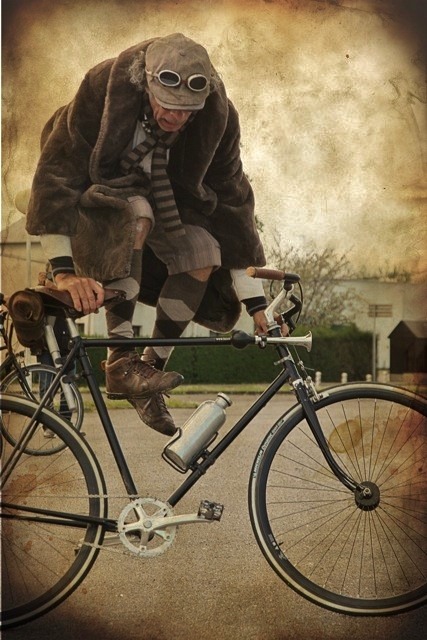
Crédit photo : Marie-Nathalie Marouillier
... suite et fin
Extrait du "Bestiaire Tarnais Oublié", de David Ernest Ailier
Le Rat d’Agoût
Le Rat d’Agoût se distingue de ses cousins, le rat des villes, le rat de cave et le rat d’hôtel, par son goût pour l’eau vive, les feuillages verdissants et les granges garnies de paille accueillante où il peut s’ébattre avec ses copines.
C’est une marotte chez lui : s’éloigner de sa rivière fétiche serait un crime ! L’Agoût ne le lui pardonnerait pas. Elle irait couler ailleurs ! Et sans elle, hélas, c’en est fini du Tarn et de la Garonne, par conséquences !
Les reliefs d’ortolans, les fricassées de poulet à la castraise, ne l’intéressent pas. C’est un végétarien exclusif, un tuberculophile raffiné qui fait bombance lorsque sa femelle lui concocte des topinambours à la crème ou des scorsonères en robe des champs. Il en raffole ! Parfois, elle le gâte en lui préparant un cornet de frites arrosées de ketchup. Son plastron en sort moucheté de rouge ce qui la rend furieuse et elle en profite pour lui faire une scène digne des meilleurs tréteaux du pays.
Puis, vînt un jour … Ô malheur !
Des scientifiques voulurent percer le secret de son pied léger, de son œil luisant, bref, de son insolente bonne santé. Ils pensaient pouvoir en tirer des enseignements pour l’espèce humaine. Ils l’invitèrent à moult apéritifs dinatoires qui se poursuivaient fort tard en compagnie de demoiselles délurées et gambillantes qui l’entraînaient dans des mambos brûlants et des boogie-woogies endiablés. On essaya de l’enivrer à grandes rasades de vin blanc ! Son préféré, disaient-ils. Rien n’y fit, pas même les meilleurs tonneaux de Gaillac. Il finit par se lasser et s’échappa par une porte oubliée qu’il déroba.
Revenu chez lui, sa donzelle lui demanda d’où venaient ces confettis dans son poil, ce mirliton dans sa bouche sans parler de ce mélange de parfums et d’alcools. Pour faire bonne mesure, elle éclata en sanglots et le voilà, lui le prince des berges d’Agoût, le maître incontesté, des monts de l’Espinouse jusqu’à Saint-Sulpice-la-Pointe, rendu à devoir lui expliquer qu’il ne s’est rien passé, ou si peu, que c’est bien elle, toujours, la dame de ses pensées et que ce n’est qu’auprès d’elle, sur les rives de la rivière de son cœur, qu’il veut vivre. Heureux …
Ce n’est qu’en lui promettant une soirée lyrique, qu’elle retrouva le calme et cessa d’imbiber plus que de raison et de liquide lacrymal, ses mouchoirs. Les journaux d’antan, d'ailleurs le relatent, mais faut-il tout croire ? … Elle lui donna un baiser à la française et, à la suite de cela, d’aucuns prétendirent qu’ils vécurent heureux et eurent beaucoup de petits rats très assidus à l’Opéra.
David Ernest Ailier
1 note
·
View note
Text
The Red Serpent: 5. Reaching the Meridian Line
Rassembler les pierres éparses, oeuvrer de l'équerre et du compas pour les remettre en order régulier, chercher la ligne du méridien en allant de l'Orient à l'Occident, puis regardant du Midi au Nord, enfin en tous sens pour obtenir la solution cherchée, faisant station devant les quatorze pierres marquées d'une croix. Le cercle étant l'anneau et couronne, et lui le diadème de cette REINE du Castel.
To assemble the dispersed stones, work with square and compasses to put them back together again in regular order. Seek the meridian line going from the East to the West, then look from the South to the North, finally in all directions, to obtain the searched-for solution, positioning oneself in front of the fourteen stones marked with a cross. The circle being the ring and crown, it is the diadem of this QUEEN of Le Castel.
The poet is clearly done with pleasantries, like introducing friends and relating long walks. In this stanza, he seriously calls one’s attention to the bigger picture. The fact that one should evidently start looking all over the place for clues, leads one to suspect that the landmarks will eventually reveal some kind of geometrical pattern too — the meaning of which, like those in the texts, is still a mystery in itself.
5.1 With square and compasses
One is now instructed to assemble the ‘sixty-four dispersed stones of the perfect cube’ and put them back together again. Exactly what ‘in regular order’ means is at this stage anyone’s guess. The relevant landmarks in the area, which seem to have been scattered randomly, therefore actually form part of a well-ordered whole — the bigger picture.
To reduce the seeming chaos to order, one is told to use two instruments, namely a square and a pair of compasses. These are the two most basic measuring instruments, which still today figure prominently in Masonic lodges. This is quite logical, as the latter had developed from earlier builders’ orders in which these instruments were paramount. A square is used to draw straight lines and rectangles, and compasses, obviously, to draw circles. These are once again antipoles, with which the poem is interspersed.
A square and compasses are mainly used to draw sketches and diagrams on paper, and in this case, the ‘paper’ is undoubtedly a map of the area. Although the map at the back of Boudet’s book (see Figure 14) only includes the region from the entrance to the Sals Valley south of the town of Serres to the Serrat Plateau south of Rennes-les-Bains, and is also not drawn exactly to scale, it shows certain landmarks that are not indicated on modern maps and that could be significant. For this reason, Boudet’s map should be used as a basic map of the area.
The poet mentions two more landmarks on the route, namely those one apparently has to regard as starting-points in order to uncover the geometrical pattern(s) in the area. The first is a spot where a certain line of longitude and a certain line of latitude cross, and the other a place that seems to be the centre of a circle. Next, one is supposed to ‘look ... in all directions’, which implies that from there, one can systematically start working towards ‘the searched-for solution’.
5.2 The St. Sulpice meridian
The obvious question now is: Exactly which of the multitude of meridians and lines of latitude crossing each other on the map is the poet alluding to?
The only meridian singled out in the document Le serpent rouge is the one indicated by the copper strip on the floor of the St. Sulpice Church in Paris. As was mentioned earlier, the floor plan of this church included in the document clearly shows this meridian, with the letters P and S and the words ‘PRAE-CUM’ next to it. This meridian runs 2°20’05.6”E of the prime meridian at Greenwich. It lies very close to the Parisian meridian — 11.4”W of it — which dates from before when the Greenwich meridian started being used as the international line of reference for coordinate systems.
On Boudet’s map, this specific line of longitude runs close to the eastern border of the area, in other words, east of the immediate area in the Sals Valley where one finds oneself at this point.
The question arising, though, is whether somebody alluding to a meridian that in all probability relates to the hiding place of a treasure, would make it this easy to pinpoint. One tends to believe that the St. Sulpice meridian would rather lead one to the exact meridian — and region — the poet has in mind.

Fig. 14. The map of Edmond Boudet
5.3 The Rose Line
In the document Au pays de la reine blanche, a meridian that might be the line one is looking for is mentioned.
Just to put this document in perspective: It was published under the pseudonym Nicolas Beaucéan, which Franck Marie in Rennes-le-Château, étude critique [40] (‘Rennes-le-Chateau, A Critical Study’) deems to be one of Pierre Plantard’s pseudonyms. The name Beaucéan refers to the Knights Templar’s flag. (The Knights Templar was a Medieval Christian military order that existed from shortly after the first crusade until 1307.) This flag comprised parallel white and black blocks — once again echoeing the white and black theme in the poem. In the documents in the French National Library, the Order of the Knights Templar is also associated with the forerunner of the Prieuré de Sion, the Order of Sion.
As for the meridian: The one referred to in the above-mentioned document is called the ‘Rose Line’, in other words, the ‘red line’, which immediately calls to mind the ‘red serpent’. According to the author of this document, the abbé Courtauly had the following to say about the Rose Line: ‘If the parishes of Peyrolles and Serres are the twin children of Saint Vincent, the parish of Rennes-les-Bains protects the heart of the Roseline.’ The Rose Line therefore runs past (or through) the church of Rennes-les-Bains. The fact that this particular line falls almost exactly in the centre of Boudet’s map, leads one to believe that this could be the line the poet has in mind.
The towns of Peyrolles and Serres mentioned in the quotation, lie to the north of Rennes-les-Bains. One can easily spot these from the lookout point on the hiking path between Roque Nègre and Blanchefort. The writer connects them with the ‘twin children’ of St. Vincent — a saint one has already come across: It is said that he is mentioned in one of the parchments allegedly discovered in Rennes-le-Château.
St. Vincent was a friend of Jean-Jacques Olier, the founder of the St. Sulpice Church, wherein a meridian is indicated across the floor. Just like Olier, St. Vincent is also associated with the leadership of the Compagnie du Saint-Sacrement, which apparently was a front (or another name) for the Prieuré de Sion.
In the above quotation, the churches of Peyrolles and Serres are linked to the Rose Line. A quick glance at the map reveals that they fall on lines of longitude on either side of the Rennes-les-Bains church. Upon closer examination, however, one discovers that these churches lie perfectly symmetrical on either side of the meridian running through the cemetery behind the Rennes-les-Bains church.[41] As the Rose Line dates from the time when these churches were built, one could allow for a minor error of a few metres. The directions in Au pays de la reine blanche therefore correspond exactly to what one finds in reality: The church of Rennes-les-Bains indeed ‘protects’ this line.
On the map, this meridian runs past Lampos in the north — the white rock formations on the slopes of Cardou. Lampos lies straight across from Blanchefort on the other side of the ravine when entering the Sals Valley from the north. South from there, the meridian runs through the Rennes-les-Bains cemetery, further south through the spot where the Sals and Blanque Rivers converge, and still further south, past a fountain called Fontaine de Madeleine (‘Fountain of the Magdalene’.
The fact that this meridian runs through the convergence of the mentioned rivers unveils a beautiful symmetry in the area. This, once again, corresponds to the balancing of the poles in the riddle, which is crucial to finding one’s way.
5.4 Lampos
According to Boudet, the name Lampos comes from the word ‘lamb’. He writes: ‘This last rock separated from Cardou and presenting several points reunited at the base, gave our ancestors the idea of small beings comprising a family ... [They] poetically named these needles Lampos. This word derives from ‘lamb’ or ‘to lamb’, when speaking of the sheep.’ [42] This rock structure does indeed look like white lambs grazing on the slopes. The poet later also connects it with the baptism of Christ, and therefore John’s words: ‘Behold the Lamb of God.’
When looking at the copper strip indicating a meridian in the St. Sulpice Church, one makes the astounding discovery that it is indeed linked to the ‘Lamb of God’. At the one end, the line runs to the gnomon in the northern wing of the church, on which it is vertically produced. Right next to the line on the gnomon there is an inscription — as well as the symbol of the Lamb of God! This inscription also appears in the document Le serpent rouge. Just as the Rose Line runs through Lampos, so the meridian line in St. Sulpice is (literally) connected with the Lamb of God. It is therefore highly likely that this symbol on the gnomon serves as an indication of where the relevant meridian lies — the one that runs through Lampos at Rennes-les-Bains!
This discovery is the first indication that the riddle in the poem and the information in the related documents possibly not only pertain to the convictions of Pierre Plantard and his circle of friends, but could also be based on a geometrical pattern in the Rennes-les-Bains region that had existed long before any of them did! Although it is certainly possible that Pierre Plantard linked the symbol of the Lamb of God on the gnomon to Lampos, the fact that both had existed long before his time implies that others before him had the exact same association in mind. It is therefore not coincidental that the meridian running through Lampos also falls in the middle of Boudet’s map, and that all the landmarks on this map can easily be ordered in respect of this meridian. This proves that Pierre Plantard did indeed have access to certain secrets that at least date from the time of the Compagnie du Saint-Sacrement.
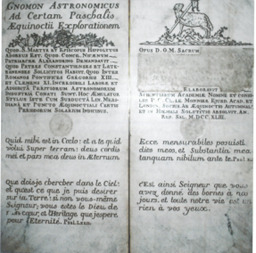
Fig. 15. The inscription on the gnomon
5.5 The Rennes-les-Bains cemetery
To reach the cemetery behind the church of Rennes-les-Bains, one takes the footpath from Blanchefort, and at the fork, the path going down to the tarred road. At the second little bridge, there are steps leading down to the water from the Pontet Fountain that flows from a pipe underneath the bridge. This water is rich in iron and leaves a reddish deposit on the ground. From here, one follows the road into Rennes-les-Bains.
It is quite a rare experience relaxing with a cold drink outside the café fronting the town square, which is shaded by the majestic plane-trees in the centre. The opposite right-hand corner of the square conceals the entrance to the passage-way that leads to the church.
When entering the vestibule, which is separated from the church itself by a door, the first thing that catches the eye is an iron cross decorated with roses, with a Virgin and Child in the centre. Underneath this cross one finds three inscriptions: ‘IN HOC SIGNO VINCES’ (‘BY THIS SIGN YOU WILL CONQUER’), ‘DOMINO VIE RECTORE’ (‘TO THE MASTER WHO SHOWS THE WAY’) and ‘PETRUS DELMAS FECIT’ (‘MADE BY PETRUS DELMAS’), with the date 1856 underneath. One immediately wonders if the abbé Vie, whose name features in the middle inscription, is the one who is supposed to show the way.
As for the third inscription: In 1856, Petrus Delmas apparently published a writing entitled L’Armorial du Languedoc-Roussillon (The armorial bearings of the Languedoc-Roussillon’) in which one or more of the antique Plantard family coats of arms appeared. The existence of such a book can, however, not be verified.
Walking straight through the vestibule, one reaches the cemetery behind the church. Here one finds the grave of the abbé Jean Vie, who died in 1872 at the age of 64. According to his epitaph, he became a priest at 32, which neatly divides his life into two parts of 32 years each, 32 ‘black’ and 32 ‘white’ years — corresponding to the Knights Templar’s flag, as well as the blocks on a chess-board.
The date on his grave, namely the 1st September, is written as ‘1 er 7 embre’, and therefore also implies 17 (in French, 7 is ‘sept’). Together with the French pronunciation of his name, ‘Janvier’ (meaning ‘January’), one therefore has an allusion to the 17th January — the same day Sigebert is said to have been brought to Rhedae. This is also the holy day of the archbishop of St. Sulpice, the patron saint of the church in Paris that had been named after him, who died on the 17th January, 647. Given the connection between this date and St. Sulpice, it is highly likely that this grave relates to the meridian indicated on the floor of the St. Sulpice Church.
Next to the grave of the abbé Vie is that of Boudet’s mother and sister. The white tombstone is bestrewn with black crystals - again the white-black theme. Between their epitaphs is a vertical line with arrowheads at the top and bottom, and one’s first thought is whether this is not perhaps indicative of the Rose Line.
As the Rose Line indeed runs past these graves,[43] there is little doubt that they are connected with it. This would imply that the cemetery not only boasts an important meridian, but also that the priests of the church had been aware of it and left all sorts of clues about it. Another grave to be found here — which later on proves to be of great significance — is that of Paul-Urbain de Fleury, the son of Paul F. Vincent de Fleury and Gabrielle, Marie de Blanchefort’s daughter.
According to Au pays de la reine blanche, the church of Rennes-les-Bains protects the ‘heart’ of the Rose Line. This ‘heart’ in all probability alludes to a point where the Rose Line and a line of latitude cross, which would imply this line of latitude is the other line the poet is referring to. The next landmark implicitly mentioned in the poem is therefore to be found here in the Rennes-les-Bains cemetery.
5.6 Mirror images
One now expects the poet to enter the church of Rennes-les-Bains. He does, after all, mention the 14 ‘stones’ marked with a cross, which undoubtedly refers to the 14 Stations of the Cross. The Stations in the Rennes-les-Bains church, however, do not include any of the peculiarities found in the Rennes-le-Chateau church, which means it is rather the latter that is relevant at this point. One therefore has to position oneself in front of the Stations of the Cross in the church of Rennes-le-Château — which forms part of the ‘all directions’ one is told to look in.
The poet switches very cleverly between the two churches of these towns. Just as one thinks one is supposed to enter the church of Rennes-les-Bains, he actually has the one in Rennes-le-Château in mind. He clearly had no intention whatsoever of making this a walk in the park.
Just as the poet metaphorically refers to the landmarks on the route as stones, so he also calls the Stations of the Cross in the church of Rennes-le-Chateau ‘stones’. There is therefore a parallel to be drawn between the route in the Rennes-les-Bains area and the Stations of the Cross in the Rennes-le-Château church. This emphasises precisely what one discovered earlier, namely that he calls the route a pilgrimage as an allusion to the Way of the Cross as depicted in the Rennes-le-Château church. The route outside the church of Rennes-les-Bains therefore corresponds to the Way of the Cross inside the church of Rennes-le-Château. These two are therefore mirror images, as it were.
One now starts noticing exactly to what extent the poet’s description of the route tallies with the inside of the Rennes-le-Chateau church. As was mentioned earlier, the description of the poet’s friend standing on Blanchefort corresponds in detail to the first Station of the Cross in this church. The high pulpit directly to the right of the first Station could certainly also be indicative of this look-out on top of Blanchefort.
In the description of the route past Roque Nègre he mentions having to chop down vegetation. This tallies with the depiction in the second Station of a boy dressed in brown, gathering pieces of wood. In the following stanza, wherein a flight is mentioned, the Pontet Fountain is the next landmark, as it is the only place in the region that can be directly linked to Sigebert.
Just after the second Station of the Cross is a statue of St. Anthony the Hermit, who, just like the boy in the second Station, is dressed in brown. The question is whether one can link St. Anthony to the Pontet Fountain — or maybe rather to Sigebert.
Astonishingly, there are indeed two things pertaining to St. Anthony that relate to Sigebert. The first is that the holy day of St. Anthony falls on the 17th January — the day (in 681) Sigebert had allegedly been brought to Rhedae. The second is that, while St. Anthony is regarded as the prince of all hermits, Sigebert (as well as his next two descendants, Sigebert V and Bera III) was also referred to as the ‘hermit prince’ as a result of his living in a cave on a hill close to Rhedae. It would therefore seem that the ornamentation between the Stations of the Cross in the church of Rennes-le-Chateau also relate to the route!
In the fifth stanza, one discovers the next landmark on the route to be the heart of the Rose Line in the cemetery behind the church of Rennes-les-Bains. The rose-decorated iron cross in the vestibule of this church could also allude to this heart. In addition, the fourth Station of the Cross is dominated by rose colours: Mary Magdalene is dressed in apricot-coloured clothes with shades of pink in the creases, and Jesus’ mother is wearing a light rosy pink dress.
Next to the fourth Station is a statue of St. Germaine of Pibrac, holding a bunch of roses in her dress. She was a shepherdess of the Languedoc who was raised to sainthood in 1867. Her story corresponds greatly to (and is probably just another version of) that of St. Roseline, whose holy day is also on the 17th January. St. Germaine’s day of remembrance, the 16th June, is also the day on which the French nun Marguerite Marie Alacoque had the vision that led to her worship of the ‘Sacred Heart’. This, too, could be related to the heart of the Rose Line.
Roses, St. Roseline and the Sacred Heart, all related to the Rose Line, can therefore be linked to St. Germaine. The similarities between the landmarks on the route and the ornamentation in the church of Rennes-le-Chateau are therefore unmistakable. This means one can again and again search the Stations of the Cross and the ornamentation for clues — precisely as the poet suggests.
5.7 The circle
After being led to the heart of the Rose Line in the Rennes-les-Bains cemetery, one is now lured to the ‘circle’. This reference is not merely to this shape — it has a bearing on another spot just a short distance from the cemetery, on the outskirts of Rennes-les-Bains, called Le Cercle (‘The Circle’). In view of the fact that compasses are mentioned, it would seem that this place is to be used as the centre of the circle one has to draw. Boudet alleges that this very spot is the centre of the stone circle that is to be found in the area.
To get to Le Cercle, one walks in a southerly direction from the church of Rennes-les-Bains down the main road. Right on the outskirts, a narrow road branches off slantwise to the right. Following this, one turns left just before the last stone building on the left-hand side.
Entering the house’s yard, one immediately sees Le Cercle — an ancient stone circle of about 7 m in diameter. The house to the left was built on top of some of these stones, which are visible at the bottom of the wall to the left of the front door. Some of the other stones are only just visible above the surface.
The poet compares this stone circle to a ring and a crown. This brings to mind the ring of Solomon, which is also associated with a treasure. The crown does, after all, have a royal connotation. According to legend, Solomon appointed the devil Asmodeus as keeper of the cave in which his treasure was hidden. One day, the king lost his seal ring, upon which the devil refused him entrance to the cave. It was only after Solomon had found the ring again that he could drive the devil away.
In accordance with this tale, the devil does indeed also figure in our story — and he has an armchair just a short distance from Le Cercle!
Figuring out how the stone circle could be symbolic of Solomon’s seal ring is the easy part. The ‘seal’ of Solomon, which is also the symbol of the poet’s friend, does, after all, have a circle as base, with all the points of the hexagram on it. One therefore has a circle here that could easily be drawn on a map, with Le Cercle as the centre thereof. This corresponds to the poet’s advice about using a pair of compasses.
What strikes one is that the two geometrical patterns that are implied in this stanza, namely two lines crossing, and a circle, correspond to the two geometrical patterns on the coded texts, namely lines that cross each other, and a hexagram. This could certainly imply that the geometrical patterns on the texts are related to the last two landmarks in the area, namely the heart of the Rose Line and Le Cercle. The latter should, by the looks of it, serve as the base for drawing the seal of Solomon (a hexagram).
Besides the ring and crown, the poet also mentions the diadem of the queen of ‘Le Castel’. The ring, crown, diadem and queen are all indicative of royalty.
This is not the first time one hears about a queen. The poet already in the third stanza refers to the ‘BEAUTY’ and ‘QUEEN’, both in upper case. In the fourth stanza, he follows it up with another reference to the ‘BEAUTY’, and here, in the fifth, with another to the ‘QUEEN’. As in the rest of the poem, everything is in perfect dualistic harmony.
The queen is of ‘Le Castel’, which either refers to a place called Le Castel, or alludes to a castle. It also calls to mind the area where our queen Blanche came from, namely Castille — a name that also has a bearing on a castle. It is furthermore reminiscent of the castle where the ‘sleeping BEAUTY’ lies.
The ‘QUEEN’ and the ‘BEAUTY’ most likely refer to different aspects of the same female figure, and ‘Le Castel’ is where one is headed. It would seem, then, that the poet is drawing more attention to the fact that the ‘solution’ of the bigger picture will only be clear once one has reached this ‘castle’.
Hope maketh not ashamed.
40. Marie, F. 1978. Bagneux: S.R.E.S.
41. The western walls of these churches provide the best reference lines.
42. Boudet, H. 1886. La vraie langue celtique ... Carcassonne. Reissue: 1984. Belisane: Nice, p. 231.
43. The grave of Jean Vie lies on 2°19'11.7"E, which I took as the Rose Line.
2 notes
·
View notes
Photo
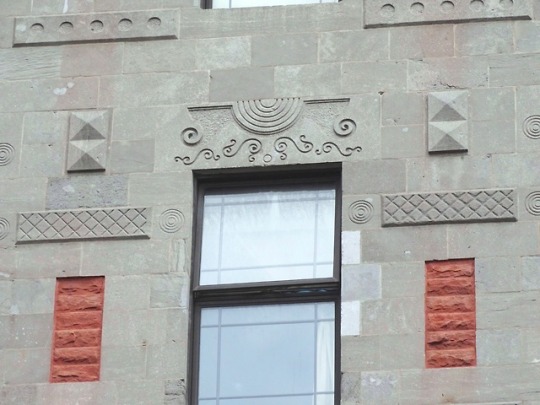
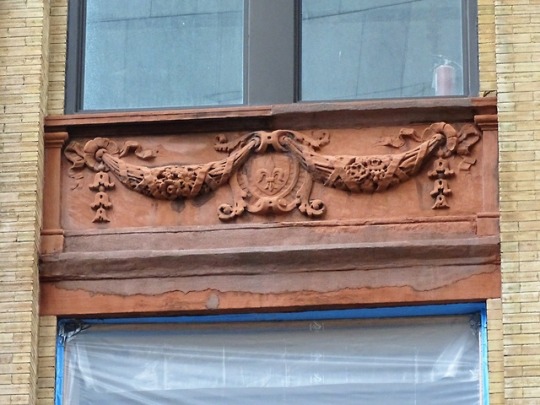
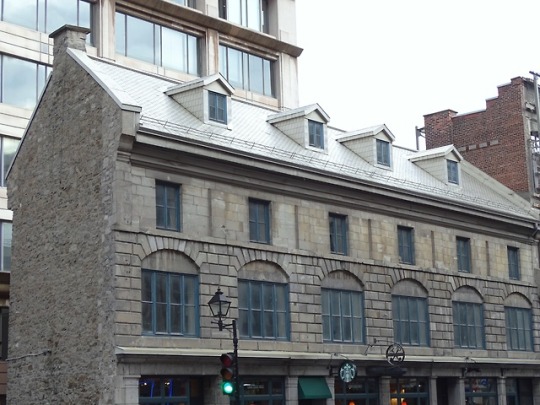
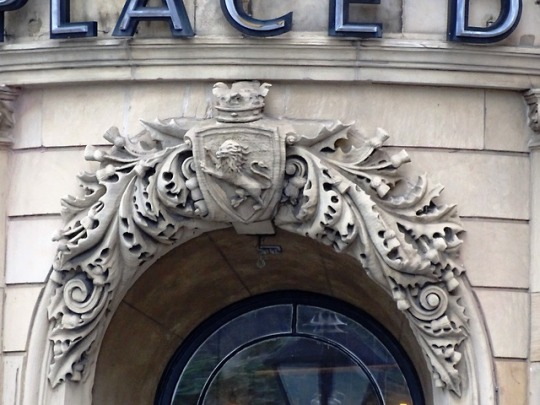

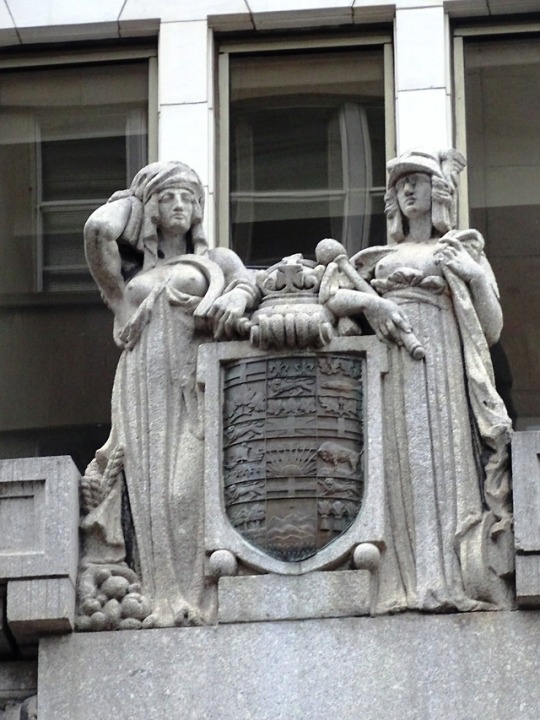
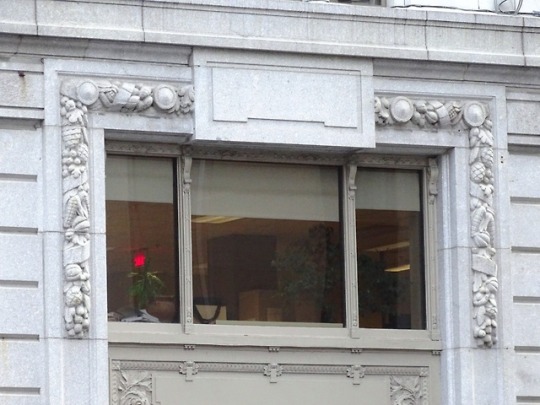
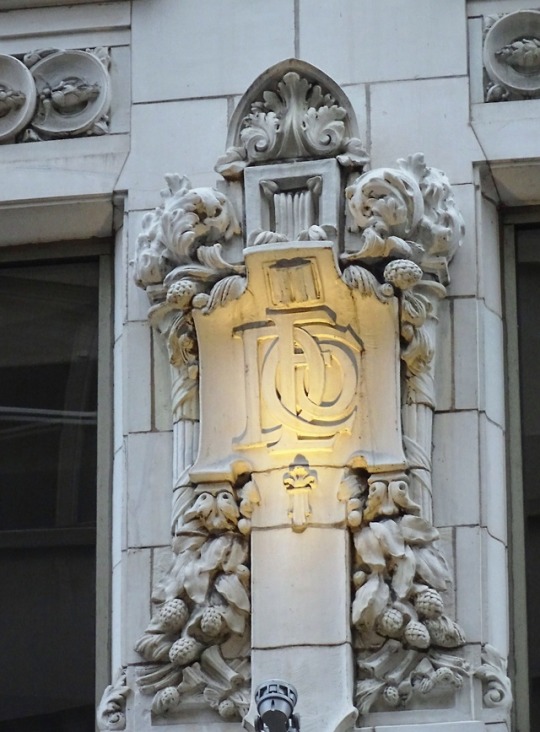

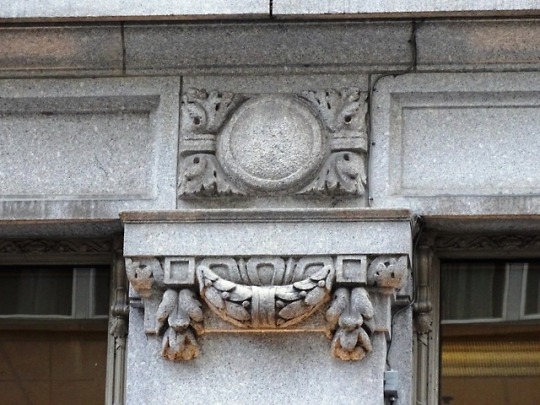
Architecture in Montréal (No. 3)
In 1605, Samuel de Champlain established a fur-trading post at Place Royale (Old Montreal) at the confluence of the Saint Lawrence River and the Petite Rivière St-Pierre, a former river in the area. It was adjacent to present-day Place D'Youville and the Pointe-à-Callière Museum. However, the settlers were later forced to abandon the outpost due to incursions by the Iroquois.[citation needed]
The original settlement of Montreal was founded in 1642. It was known as Ville-Marie, and was located in roughly the same location as the trading post set up by de Champlain. The founder, Paul Chomedey de Maisonneuve, built a fort in 1643 which would serve as the headquarters for the Société Notre-Dame de Montréal, an organization whose mission was to convert members of First Nations to Christianity and establish a Christian settlement in New France. The company in charge of managing the settlement was founded by the Sulpician Jean-Jacques Olier and by Jérôme Le Royer (Sieur de La Dauversière).
After the Société Notre-Dame dissolved on March 9, 1663],[3] the Sulpicians (who arrived in 1657) became the Seigneurs of Montreal, as King Louis XIV of France took personal control over the colony. The new system gave them the island of Montreal, with the obligation to live there and insure its development by cultivating the land. In 1665, Louis XIV sent 1,200 men from the Régiment de Carignan-Salières. The Sulpicians organized seigneuries at the center of the island. François Dollier Casson established the first grid of streets in the colony, following the paths of existing trails. These early streets included the Rue Notre-Dame, the Rue Saint-Paul and Rue Saint-Jacques. Buildings of the era include the Hôtel-Dieu de Montréal, the Saint-Sulpice Old Seminary and Notre Dame Church (replaced later by the Notre-Dame Basilica).
In the early 18th century, the name "Montreal" (which originally referred to the mountain Mont-Royal) gradually replaced that of Ville-Marie. The arrival in 1657 of Marguerite Bourgeoys (who founded the Congregation Notre-Dame) and the arrival of the Jesuits and Recollets in 1692, helped to insure the Catholic character of the settlement. The original fortifications of Montreal, erected in 1717 by Gaspard Chaussegros de Léry, formed the boundaries of Montreal at the time. De Léry had the fortifications constructed to secure the settlement from a British invasion and to allow future expansion inside the walls. Though the walls may have provided security from invasion, they created a different problem: a large concentration of wooden houses (with fireplaces) led to many devastating fires. In 1721, Montreal received a royal order from France to ban wood construction; buildings were to be constructed using stone, but the ban was never fully respected.
Source: Wikipedia
#Pavillon Marcelle et Jean Coutu#architecture#art deco#original photography#cityscape#Maison Cuvillier-Ostell#detail#close up#window#Old Montreal#Québec#canada#summer 2018#landmark#tourist attraction#facade#building ornament#Édifice Dominion Express.#stone carving#Montréal#travel#vacation#road trip#exterior
1 note
·
View note